GUARDIAN

Issue 3 www.cvsa.org


Issue 3 www.cvsa.org
n
n
n
n
GUARDIAN
“Guardian” is published quarterly by the Commercial Vehicle Safety Alliance with support from the Federal Motor Carrier Safety Administration. CVSA and FMCSA are dedicated to the government and industry working together to promote commercial motor vehicle safety on North American highways.
Copyright 2025, CVSA. All rights reserved. No part of this issue may be reproduced without written permission from the publisher.
For comments, suggestions or information, email communications@cvsa.org.


CVSA is looking for interesting, relevant content for its quarterly magazine. We would be happy to consider your news, ideas, insights and articles on issues facing the commercial motor vehicle safety community for upcoming editions of “Guardian” magazine.
The deadlines for upcoming editions are available at www.cvsa.org/guardianmagazine/deadlines-for-submissions.
Questions? Please contact CVSA Writer-Editor Emily Moorhead at emily.moorhead@cvsa.org.

By Capt. John Hahn, Motor Carrier Safety Section, Colorado State Patrol; CVSA President
By the time everyone reads this, we will be closing out the summer and preparing for fall and winter ahead. Baseball will be nearing its end, and we will be preparing for the return of hockey. It will be a change of seasons in many respects. For me, it will be nearing the time for me to complete my term as CVSA president. In my final article to the membership, I wanted to take just a moment to speak from a personal perspective on what CVSA is and what it means.
As I related in my first article, I did not “grow up” in my agency in commercial motor vehicle (CMV) enforcement. The path to my current role had several stops along the way, from working the road as a trooper, to being a field sergeant, to working at headquarters, the state capitol and in our hazmat unit. The one thing that sticks out to me as I look back at that journey is how unique this Alliance truly is. There is nowhere else where we, in the enforcement community, experience a similar reality.
When I first arrived in my role as the new commander of our hazmat unit, I knew some things about the CMV world from my time as a road trooper. At that point, all of our troopers went through North American Standard Inspection Part A during their last week in the academy. The sum total of my knowledge then was that I needed to get 32 inspections accomplished to remain certified and avoid getting into trouble. I had zero real knowledge of CVSA and what the organization does – and even less knowledge about its greater impact on safety.
Fast forward to my first CVSA event, an annual workshop in Los Angeles, California, where I did not understand at all what was going on or the conversations that were taking place. It became very clear to me that I was surrounded by people who were incredibly knowledgeable about what they were doing. I also knew that it was something I wanted to be a part of. My understanding of the organization and appreciation for what we do grew quickly as I began to understand how very different this organization is from any other.
Nowhere else do enforcement personnel, regulators and the regulated community all convene on a regular basis to tackle the challenges of the day. There is no such group in any other sector of the enforcement world.
While there may be groups and associations that focus on things like transportation, there really isn’t a place where everyone is not just involved in the discussion but is also a part of the decision-making process to find solutions.
Many people often see CVSA solely through the lens of the roadside inspection program and the out-of-service criteria. These two things are central to who we are as an organization, but they are not what makes us so unique. I would challenge our membership to look at our organization much more broadly than that.
Jurisdictions at the local, state, provincial and territorial levels are charged with enforcing laws and safety regulations pertaining to CMVs in North America. Imagine a world where all jurisdictions operated in their own way by applying the regulations differently and determining unilaterally what constitutes an imminent hazard. Imagine a circumstance where there was no level of reciprocity nor any concerted efforts to engage with industry and federal partners. Imagine a situation where challenges were to arise in various aspects of what we do, and there was nowhere to go for guidance and nowhere to engage with peers in any meaningful, collaborative way. For our associate members, imagine if there was no forum to work through issues with other industry leaders, and enforcement was patchwork at best.
CVSA is not just an organization that provides a roadside inspection program and outof-service criteria. It is a gathering place of ideas and input. It is a place where the enforcement and regulatory community sits next to the very people who are the subject of that enforcement, with a shared goal of
solving problems. Ours is an organization that is not just about serving as the hallmark for consistency across three nations.
Many in the law enforcement community know of Sir Robert Peel, likely having heard of him at some point in the course of their training. For those who do not know, Peel was a 19th-century statesman often recognized as the father of modern policing. One of his contributions was Peel’s Principles of Law Enforcement. Frequently quoted by many, one of his key principles was this: “The police at all times should maintain a relationship with the public that gives historic tradition that the police are the public and the public are the police.” We see this principle often playing out in community meetings and gatherings across North America, where enforcement personnel place themselves at the same table as the community they serve.
While the functions we perform inside our organization are critical to CMV safety, I would say that the function of our Alliance is to be the conduit outlined so well in Peel’s principles. CVSA serves as the very best example I can think of where enforcement and the community enforced upon and served are the same thing. If our organization can serve as a hallmark for anything, it would be that we are a gathering place for handling the most pressing challenges we face – a place where everyone is at the table and where we all are representative of the people we serve and who we serve with.
As I close out my term as president, I will simply say thank you. Thank you for the opportunity to represent your amazing efforts and for the opportunity to serve alongside each of you. n
"The police at all times should maintain a relationship with the public that gives historic tradition that the police are the public and the public are the police."
–Sir Robert Peel

By Collin B. Mooney, MPA, CAE, Executive Director, Commercial Vehicle Safety Alliance
The approximately 13,000 enforcement officials who make up CVSA’s core membership are responsible for the day-to-day execution of all elements of the commercial motor vehicle (CMV) roadside enforcement and inspection activities under the North American Standard Inspection Program. As the organization that represents the CMV enforcement community, CVSA has a vested interest in the continued success of the program. The consistency and uniformity in the application of the CMV roadside enforcement and inspection process, and the data generated from this activity, form the cornerstones and foundation of the program.
The Alliance actively works to reduce crashes, fatalities and injuries involving CMVs through a combination of activities, such as enforcement of the CMV safety regulations; monitoring CMV regulatory effectiveness; development and delivery of training materials for the CMV enforcement community and the motor carrier industry; identifying, recommending, and implementing enforcement and inspection data quality improvements; improving crash reporting and data collection; and various outreach initiatives to the motor carrier industry, the enforcement community and the general public.
Through a partnership with the Federal Motor Carrier Safety Administration (FMCSA), CVSA’s state, provincial, territorial and local members, and industry, the Alliance helps to ensure that both the CMV enforcement community and the motor carrier industry understand the CMV safety regulations, know how to interpret the roadside enforcement and inspection data, and be knowledgeable of the CMV crash investigation and reporting protocols. This activity leads to uniform enforcement and improved compliance, promotes safe practices and fosters a better working relationship with the motor carrier industry.
Regarding CMV enforcement and inspection data management and quality, consistent, timely and accurate data is critical to a member jurisdiction’s CMV enforcement and inspection activities. Enforcement personnel within member agencies use data from motor carriers’ past performance to prioritize motor carriers for roadside inspections, safety audits and
compliance reviews. Roadside inspection data identifies trends and areas where improvement is needed. For member jurisdictions in the U.S., the data is used to craft Motor Carrier Safety Assistance Program Commercial Vehicle Safety Plans, determining resources for enforcement and education initiatives targeting specific safety problems.
Throughout North America, data from roadside inspections is improving; however, more improvement is necessary. Inconsistencies in violation documentation and human error during the data collection process result in discrepancies in roadside inspection data. Data quality assurance is a crucial component of any program’s effectiveness, providing federal, state, provincial, territorial and local agencies the information they need to make strategic decisions regarding the investment of their limited resources. Accurate data is critical to the overall success of our collective CMV enforcement and inspection programs.
As CMV enforcement initiatives continue to grow and evolve, CVSA aims to help improve overall data quality within the CMV enforcement and inspection program. As a result, over the past few years, CVSA has organized, coordinated and implemented a three-day system-wide training event for all state personnel dedicated to data management and quality control practices and to provide subject matter expertise to FMCSA. The objective is to improve the uniform collection and analysis of CMV roadside enforcement, inspection and crash data generated by nearly 4 million annual roadside inspections. This annual training helps to ensure that crash records and inspection data reports are consistent, timely
and accurate. In addition, CVSA continues to provide input regarding what updates are needed in developing or maintaining relevant FMCSA data systems.
CVSA offers recommendations and participates in FMCSA’s inspection modernization effort by facilitating state input and providing technical feedback, as appropriate. Additionally, CVSA has been active in developing operational policies and guidance, correctly mapping and classifying roadside data consistently across all jurisdictions throughout North America. Recommendations for hardcoding violations and implementing smart logic for the inspection software will further enhance CMV enforcement and inspection data quality. Accurate roadside data recordation, through reduced human error, will enhance decision-making for FMCSA and the states. Subsequent DataQ challenges for incorrect violations or incorrect designation of an out-of-service condition will be reduced through hardcoding efforts.
In closing, CVSA is committed to improving driver, vehicle and motor carrier safety through a variety of activities, including national enforcement and education campaigns, support of innovative safety technologies that improve safety, critical mandatory in-service/refresher inspector training, data quality improvements, production of roadside enforcement training multimedia and crash reporting. These initiatives also include targeting unsafe driving in high-risk crash corridors and rural roads, improving the safe transportation of goods and persons in foreign commerce, improving CMV safety and compliance with safety regulations, and public awareness and education. n
By Sgt. Dickie Murchison, Traffic Services Unit, Connecticut State Police
On May 15, the Connecticut State Police Traffic Services Unit, managed by Sgt. Dickie Murchison; the Connecticut Department of Motor Vehicles (DMV) Commercial Vehicle Safety Division (CVSD), managed by Sgt. William Vieweg; and federal and other state law enforcement agencies conducted a multiagency commercial enforcement operation at the Union weight/safety facility located on I-84 westbound in Union, Connecticut.
The operation, called COBRA (Collaborative Operations by Response Agencies), utilized multiple law enforcement resources with specific disciplines to identify carriers, commercial motor vehicle (CMV) drivers and CMVs performing unsafe and/or illegal activities while engaged in commerce and operating on a public roadway.
The mission of the Connecticut State Police Traffic Services Unit and the Connecticut DMV CVSD was to identify CMVs and/or their drivers violating Federal Motor Carrier Safety Regulations (FMCSRs) and Connecticut General Statutes relating to motor vehicles. Connecticut State Police and Connecticut DMV then investigated if additional state or federal laws were being broken and used the proper resources available to conduct a complete investigation with law enforcement partners. This included, but was not limited to, FMCSRs, narcotics trafficking, human trafficking, undeclared hazmat, cargo theft and stolen trailers, weapons trafficking and violations of local laws pertaining to oversize and weight.
Before the operation, all personnel met at the Union weight/safety facility, where they were given an operational plan, put together by the Connecticut State Police Traffic Services Unit and the Connecticut DMV CVSD. Though fluid, this plan provided specific assignments to law enforcement personnel for maximum effectiveness and efficiency. The assignments given to Motor Carrier Safety Assistance Program (MCSAP) personnel covered not only the weight/safety facility but also eastbound I-84 CMV traffic and secondary roads within the area, stopping trucks that exited the highway to avoid the weight/safety facility.
The Connecticut State Police Traffic Services Unit and the Connecticut DMV CVSD worked alongside other state and federal agencies. The additional agencies involved in this operation included the Transportation Safety Administration, the U.S. Department of Transportation Office of Inspector General, the Connecticut Department of Transportation, the Connecticut Department of Energy and Environmental Protection, and additional
With multiple agencies involved in this operation, a unified command structure was put into place. This structure allowed agencies to assign incident commanders and give them functional responsibility to represent each agency. It also provided a common set of objectives and strategies, with a collective approach to reaching the incident objective. During the COBRA operation, MCSAP personnel conducted 40 inspections, including 11 Level I, 23 Level II and six Level III Inspections. Three drivers and 20 vehicles were placed out of service. Additionally, two CMVs were towed from the scene.
After the operation, a debriefing occurred at the Union weight/safety facility. Each agency recorded its respective statistics related to the operation, which will be used to compare to past operations and set the pace for future operations.
In conclusion, the COBRA operations have been a success since their inception in 2017. Future COBRA operations are scheduled throughout the year at various weight/ safety facilities in Connecticut, working collaboratively with multiple law enforcement agencies to make the roadways safe. n


Region I
Connecticut, Delaware, District of Columbia, Maine, Maryland, Massachusetts, New Hampshire, New Jersey, New York, Pennsylvania, Puerto Rico, Rhode Island, U.S. Virgin Islands and Vermont
Region II
Alabama, American Samoa, Arkansas, Florida, Georgia, Kentucky, Louisiana, Mississippi, North Carolina, Oklahoma, South Carolina, Tennessee, Texas, Virginia and West Virginia
Region III
Colorado, Illinois, Indiana, Iowa, Kansas, Michigan, Minnesota, Missouri, Nebraska, North Dakota, Northern Mariana Islands, Ohio, South Dakota and Wisconsin
Region IV
Alaska, Arizona, California, Guam, Hawaii, Idaho, Mexico, Montana, Nevada, New Mexico, Oregon, Utah, Washington and Wyoming
Region V
Alberta, British Columbia, Manitoba, New Brunswick, Newfoundland and Labrador, Northwest Territories, Nova Scotia, Nunavut, Ontario, Prince Edward Island, Quebec, Saskatchewan and Yukon
By Sgt. Justin Willis, Commercial Motor Vehicle Enforcement Section, Public Service Commission of West Virginia
In the world of commercial motor vehicle (CMV) enforcement, we often think of inspections and routine day-to-day activities. However, on May 14, during the CVSA’s International Roadcheck, I, along with Cpl. Jack Woods of the West Virginia State Police – CMV Enforcement Section and his K-9 partner, found ourselves in a situation much deeper than just a routine CMV inspection. I was working the second shift post at the Bluestone Travel Plaza located on the West Virginia Turnpike on I-77. During my shift, which began at 3 p.m., I was training an officer who was conducting Level III Inspections. As the evening progressed, I didn’t realize I was about to uncover something much deeper than a violation.
I was standing at the cones that blocked off the parking lot area where CMVs would drive by so officers could determine which vehicles to inspect. Around 5 p.m., just two hours into my shift, I observed a white tractor-trailer entering the area and decided to pull it for a random inspection. As the tractor-trailer approached, the driver appeared to ignore me and pass by without stopping. I ran across the parking lot to chase down the truck and make the driver pull into the inspection area. The driver positioned his truck at an angled position instead of pulling into the marked parking area. He rolled down his window and left the truck running.
I advised the driver that I would be conducting a Level II Inspection and asked him to open the door so I could gather his documents.
At this point, I began noticing several things that indicated that this was something more than a random inspection. As I started the driver interview, the driver began sweating profusely. I observed the air conditioning was on high, and the cab was extremely cold, so the driver should not have been sweating. After gathering information about the load, the driver got out of the truck, under the guise of throwing away trash, but he was looking around the area, specifically into a wooded area with a field nearby. I asked the driver to get back in his truck, and while I waited for him to return, I went back in my cruiser to run the driver’s information through the Commercial Driver’s License Information System.
The query came back as not eligible on his commercial status, as well as not eligible on his regular driver’s license. I called 911 to check with the dispatcher on the status of the driver and perform a warrant search. Meanwhile, I continued to observe the driver’s behavior as I made my phone calls. The driver exited the truck several more times, changing his shoes and looking across to the wooded area. Cpl. Woods and his K-9 stuck close by to assist if needed.
I received a response from the dispatcher, inquiring, "Sir, are you secure?" – and in this moment, I knew I had run across something more serious than just a suspended operator. The driver had a full extradition warrant from Kentucky. I requested the dispatcher send off for a hit confirmation and extradition confirmation, and I asked Cpl. Woods to run his K-9 to check the vehicle, as the warrant didn’t have charge information initially available. The dispatcher notified me that they did have confirmation, and they would do a full extradition. It turns out the driver was wanted by the FBI Kentucky Division for multi-state wire fraud and conspiracy to commit wire fraud. Cpl. Woods and I took the driver into custody and turned him over to the FBI without incident.
I reaffirmed several lessons that day. Trust your gut. Prioritize officer safety. Both lessons remain paramount to CMV enforcement. Be safe, everyone.
If this motor carrier had better understood its responsibilities and liabilities, this driver and vehicle would never have been allowed to leave the yard. I can honestly say I made a difference that day on our roadways. n

The West Virginia Public Service Commission (WVPSC) recently took home two awards from the Governors Highway Safety Program’s (GHSP) “Highway 2 Safety” traffic safety conference May 14-16 in Bridgeport, West Virginia.
WVPSC came in eighth place for speed enforcement and fifth place for seatbelt enforcement. It is notable that while the other contenders deal with both passenger vehicles and commercial motor vehicles (CMV), WVPSC only interacts with CMVs, meaning they enforced enough speed and seat belt violations in CMVs alone to receive these awards. Their efforts equated to 539 speed citations on highway safety enforcement and 320 seat belt citations on highway safety enforcement.
WVPSC conducted this enforcement under a grant funded by GHSP. The work shifts are voluntary overtime grant shifts, and each month has a different focus topic, such as seatbelt usage, distracted driving, speed patrol and work zone safety. WVPSC has about 20 officers who participate in this program. CVSA Director of Enforcement Programs Jake Elovirta also attended the conference and participated in a roundtable discussion on commercial motor vehicle enforcement, education, training and resources, along with three WVPSC employees: Robin Lassak, who served as moderator, Sgt. Justin Wills and Capt. A. W. Ryan. n
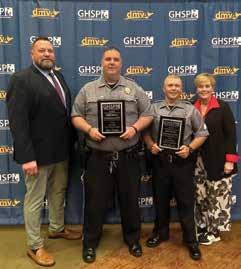
By Lt. Shawn Gobble, Motor Carrier Safety Unit, Virginia State Police
The Port of Virginia is the fifth-largest container port in the U.S., spanning 1,864 acres. It features 19,885 linear feet of berth space, 50-foot-deep channels, and 48 kilometers (30 miles) of on-dock rail. The port handles over 2.3 million twenty-foot equivalent units (TEUs) of cargo annually and is one of the busiest seaports in the U.S., adding over $153 billion to the U.S. economy each year.
Every May, the Virginia State Police Motor Carrier Safety Unit conducts the annual Spring Port Check at the Port of Virginia. This project utilizes Motor Carrier Safety Unit troopers from across the Commonwealth for the fiveday concentrated check project. The project has been highly successful for the past several years due to its immeasurable contribution to highway safety. It has become a biannual project focusing on the safety of both drivers and equipment used to move massive amounts of cargo from the port to locations across the U.S.
Troopers were assigned to 12-hour shifts each day and completed more than 700 inspections. The project resulted in 554 Level I, 65 Level II and 113 Level III Inspections, as well as 375 CVSA decals issued. Over 789 total violations were cited during the five-day project. Of the violations cited, 136 were outof-service (OOS) violations for the power unit and driver, and 653 were non-OOS violations.
Total chassis violations cited during the project were 170, with 30 OOS violations.
The annual Fall Port Check will be conducted with the goal of making highways safe, not only in the Commonwealth of Virginia but across the U.S. n


By Monica Greiss, North Carolina State Highway Patrol
1st Sgt. Brandon Vick of the North Carolina State Highway Patrol’s (NCSHP) Commercial Vehicle Enforcement (CVE) Section recently completed the 101st session of the North Carolina State University Administrative Officers Management Program (AOMP).
AOMP, established in 1989 through the School of Public and International Affairs at North Carolina State University, is a premier educational initiative designed to prepare public safety professionals for administrative and leadership roles. Held three times annually – spring, summer and fall – the program is a 12-week, in-residence experience at the NCSHP Training Academy in Raleigh, North Carolina.
Each session is composed of 25 public safety professionals nominated by their agencies. Participants earn 15 academic credits (nine undergraduate, six graduate) and receive a certificate of completion. AOMP emphasizes a theory-to-practice framework, integrating current academic research with real-world public safety management challenges. The result is a powerful environment for innovation, collaboration and professional growth.
Commercial motor vehicles (CMV) play a vital role in the economy, transporting goods across vast distances daily. However, their size and operational characteristics present unique challenges to motorists. Traffic crashes involving CMVs often result in severe consequences due to the vehicles' size, weight and limited maneuverability. Recognizing this issue, 1st Sgt. Vick leveraged his opportunity at AOMP to conduct focused research on improving public safety through enhanced driver education – specifically, the need to better equip drivers with the knowledge and skills to safely interact with CMVs on public roadways.
1st Sgt. Vick’s initiative reflects the mission of AOMP: to cultivate forward-thinking leaders who identify challenges and implement actionable solutions. His work exemplifies how law enforcement professionals can drive policy reform and public safety improvements beyond traditional enforcement roles.
As the transportation landscape continues to evolve – with increasing freight movement, driver shortages and autonomous vehicle technology – such leadership and research are essential to ensuring the safety and adaptability of our roadway systems. n
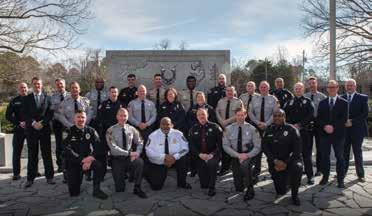
By Tpr. Brandon S. Johnson, North Carolina State Highway Patrol
In the early morning hours of Jan. 21, the quiet of Forsyth County’s stretch of I-74 was broken by a life-or-death emergency that would underscore the true meaning of public service. At approximately 7 a.m., NCSHP Tpr. Mills responded to a call involving a vehicle stopped in the middle of the interstate at US-421. The driver was unresponsive, suffering from a severe medical condition that left him incapacitated behind the wheel.
Joined by License and Theft Agent C. Angel, Tpr. Mills acted without hesitation. Together, they quickly removed the unconscious driver from the vehicle and began administering CPR. Recognizing the urgency, Tpr. Mills retrieved his AED and deployed it in a courageous attempt to revive the individual. The duo continued life-saving efforts until emergency medical services arrived on the scene and took over care.
His actions reflected the core values upheld by NCSHP CVE. n


By Monica Greiss, North Carolina State Highway Patrol
NCSHP CVE Section members presented at the Volvo Group North America Safety Recall Summit. The members in attendance were Capt. T. G. Wilson, 1st Sgt. B. D. Vick, Sgt. M. G. Conley and Tpr. W. S. Skinner. Sgt. Conley conducted a traffic safety information presentation on the 37-step North American Standard Level I Inspection while Tpr. Skinner demonstrated the inspection. This is NCSHP CVE Section’s second year presenting at the summit. n
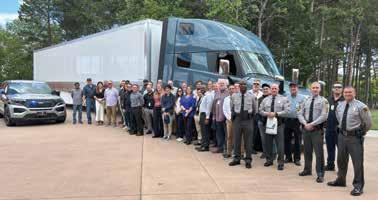


By Sgt. Joe Berrong, North Carolina State Highway Patrol
It was just after 10 p.m. when I received the call. One of my troopers on I-26 had encountered something he had never seen in his career. A CMV had pulled over after spotting the trooper’s marked patrol car. The driver wasn’t lost, broken down or in violation. He was seeking help.
The driver, clearly shaken, explained that he was brought into the U.S. from Eastern Europe by a motor carrier that promised him work and opportunity. But what he found instead was something far more sinister. The carrier had reportedly taken control of his documents and forced him to drive nearly nonstop – far beyond the federally mandated hours-of-service regulations. He was given little or no time off, and any mention of rest was met with pressure and threats. His “debt” for being smuggled into the country was held over his head like a chain. He was told he had no choice but to keep driving, day in and day out, until it was paid off.
The trooper, recognizing this as something far outside the normal scope of a roadside interaction, called me immediately. While we are trained to spot hours-of-service violations, equipment issues and falsified logs, few officers expect to uncover a potential human trafficking case on the shoulder of a highway.
Human trafficking for labor is a hidden crime, often cloaked in the appearance of employment. It takes vigilance – and often the courage of the victim – to bring it to light. Fortunately, this driver had the courage to pull over and ask for help.
In North Carolina, the State Bureau of Investigation (SBI) is the lead agency for human trafficking investigations. Upon confirming the seriousness of the allegations, we contacted local SBI agents and initiated the appropriate response. The driver was connected with resources and services to ensure his immediate safety and to begin the process of rebuilding a life free from coercion and exploitation.
The SBI conducted an evaluation to determine the driver’s classification as a trafficked individual, which allowed tailored support to be provided, ranging from housing and legal aid to victim advocacy and immigration guidance.
This case is a powerful reminder: human trafficking isn’t confined to urban centers or back alleys. It can ride silently down our highways, hidden in plain sight behind the wheel of a commercial truck. It can be disguised as a job, a promise or an opportunity. As law enforcement officers, we must remain alert not just to violations of law but to signs of exploitation and abuse that may lie beneath the surface.
Thanks to the vigilance of one trooper – and the bravery of one driver – we were able to break that silence on I-26. n
Continued on next page
By Tpr. B. P. Daniels, North Carolina State Highway Patrol
On May 5, I traveled to Louisville, Kentucky, to speak on cargo theft prevention at the 2025 Transported Asset Protection Association (TAPA Americas) T1 National Cargo Theft Summit. More than 350 supply chain professionals attended, including manufacturers, shippers, carriers, brokers, insurers, security service providers and law enforcement officers. In my presentation, I shared practical ways to prevent cargo theft. Additionally, law enforcement professionals from across the U.S. and the Peel Region of Ontario, Canada, attended and shared presentations on their various areas of specialized expertise.
I began my presentation, “Partnerships for Safer Communities – Combating Cargo Theft,” by emphasizing the vital importance of collaboration and well-established working relationships between the law enforcement and supply chain communities. The goal of this program is to educate, encourage and empower all participants to enhance their vital role in the proactive detection of criminal behavior prior to the point of compromise and to deter a criminal act from being carried out. In other words, I call it “protecting your brand.”
There are three expectations of the program: Through education and raising awareness, we will become better equipped to take a proactive approach to mitigating risk before a cargo theft occurs.
We will effectively establish and maintain a network of dedicated professionals who continuously collaborate to greatly reduce criminal activity within the supply chain. We will increase our effectiveness in the workplace through trust, collaboration, communication and vigilance.
The point of compromise can be prevented through the following:
Site security
Carrier verification and selection
Vehicle and driver violations
Vehicle and driver security measures
(physical security devices and vigilance)
In-transit monitoring and escorted highvalue load shipments
I also spoke on the effectiveness of utilizing a “rapid assessment” technique taught in the Federal Motor Carrier Safety Administration’s (FMCSA) Drug Interdiction Assistance Program CMV Interdiction course. A rapid assessment can also be conducted when interviewing carrier representatives and the drivers who come on-site to take delivery of products for shipment. A rapid assessment is highly effective in quickly distinguishing the professionals in the industry from the bad actors of the criminal element seeking to defraud and deprive companies of their products, which is the commonality of all cargo theft.
Cargo theft has increased dramatically on an international scale, and the negative effects on businesses and consumers are very costly. Cargo thefts are carried out in various ways, including straight theft, pilferage and strategic theft, such as double-brokered loads, hostage loads and fictitious pickups.
According to its annual analysis, CargoNet reported unprecedented levels in 2024, with 3,625 incidents representing a stark 27% increase from 2023. The estimated average value per theft rose to $202,364, up from $187,895 in 2023. Each quarter of 2024 surpassed previous comparable quarters in 2023, though the margin of increase narrowed as the year progressed. The most dramatic spike occurred in Q1 2024, with 317 more incidents than the same period in 2023, while Q4 2024 showed a more modest increase of 94 incidents, representing an 11.81% yearover-year growth.
I currently serve on TAPA Americas’ Law Enforcement Committee, which is actively
seeking new membership at no cost to active law enforcement officers. In May of 2025, TAPA Americas launched a Law Enforcement Grant Program to support law enforcement agencies through education and training, thereby enhancing their ability to prevent and reduce cargo theft.
TAPA Americas’ mission is to minimize cargo losses from the supply chain. The organization achieves this through developing and applying global security standards, recognized industry best practices, technology, education, benchmarking, regulatory and law enforcement collaboration, and the proactive identification of crime trends and supply chain security threats. Key to TAPA Americas’ mission is the critical work done by law enforcement agencies and active law enforcement personnel. The TAPA Americas’ law enforcement grants will help fund professional training and education for these groups that would otherwise be costprohibitive.
Two of the greatest benefits of being a member of TAPA Americas and attending a National Cargo Theft Summit are networking and continued learning. Several people approached me after my presentation to express their gratitude and were eager to discuss what they had learned with their colleagues in their respective workplaces.
I have been a CVSA-certified inspector with NCSHP since November 2007 and proudly serve with the CVE Section, the Criminal Interdiction Unit and the K-9 Unit. I will retire from NCSHP on Aug. 1. I encourage everyone to keep an open mind to learning and remain vigilant in their daily duties. n

By Sgt. M. G. Conley, North Carolina State Highway Patrol
NCSHP CVE Section members have recently completed an intensive series of advanced training sessions designed to enhance the quality of post-crash collision investigations. This initiative reflects NCSHP’s ongoing commitment to improving accident analysis capabilities, aligning with FMCSA’s Crash Causal Factors Program Study.
The training included a rigorous five-day Advanced Post-Crash Inspector Course, supplemented by three specialized classes led by the Forensic Training Group. These additional sessions addressed critical components of traffic crash investigation, focusing on heavy vehicle crash reconstruction techniques, event recorder analysis using advanced tools like the Forensic Link Adapter and Smart Sensor Simulator 2 (SSS2) and targeted training on heavy vehicle event data recorder (HVEDR) analysis.
The Advanced Post-Crash Inspector Course is an innovative program designed to equip NCSHP members with essential forensic skills crucial for conducting thorough
examinations of CMVs involved in accidents. This comprehensive training underscores the importance of identifying causal factors that lead to roadway incidents, which is vital for supporting reconstruction efforts and related legal proceedings.
The curriculum is structured to blend theoretical instruction with hands-on fieldwork, allowing members to acquire practical experience in executing post-crash inspections. The training is grounded in current evidence and best practices, enabling members to enhance their capabilities in conducting meticulous inspections, recognizing violations, identifying contributing factors and effectively documenting their findings. In an era when road safety and effective accident analysis are paramount, the course signifies a significant step forward in strengthening the forensic investigation skills of NCSHP.
Another key element of the training was the Heavy Truck Reconstruction Techniques Course, which offered an intensive five-day educational experience tailored for members specializing
in vehicle traffic crash reconstruction. This program equipped members with essential skills to evaluate the performance and dynamics of heavy vehicles involved in traffic crashes.
Throughout this training, members learned to assess heavy vehicle stopping capabilities and gained insights into the complexities of reconstructing axle weights. These factors are pivotal for understanding vehicle stability during incidents. The program also included hands-on practice, allowing members to calculate dynamic vehicle rollover thresholds, a critical skill for accurately analyzing accident scenarios involving heavy trucks.
Today, when data drives decision-making and safety enhancements in the heavy vehicle industry, the HVEDR analysis training has become a pivotal program for our members. This comprehensive four-day training course delved deep into the intricacies of HVEDR digital data analysis.
Continued on next page
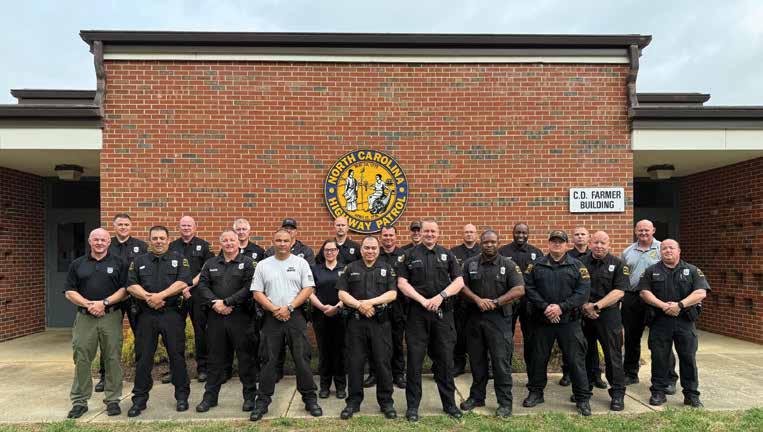
Continued from page 9
The training commenced with an interactive session, laying the groundwork for the critical components of HVEDR technology. Members engaged in extensive validation exercises, exploring various research articles and previous studies that addressed the collision mitigation processes employed by leading original equipment manufacturers, including Wabco, Bendix and Detroit Assurance.
One of the standout features of this course was its hands-on approach. Members were given the opportunity to analyze actual cases of digital data from the field. This real-
world application not only helped members relate theory to practice but also enriched their understanding of how real-time data influences safety protocols and incident analyses.
The curriculum further included a specialized lecture focusing on expert evidence, outlining common pitfalls and traps to avoid when interpreting digital data. This segment was particularly beneficial for those making informed decisions based on HVEDR insights, emphasizing the importance of accuracy and caution in data interpretation.

In summary, the HVEDR analysis training was more than just an educational experience; it was a vital step toward building a more knowledgeable workforce adept at leveraging digital technologies to enhance safety and performance in heavy vehicle operations.
As the industry continues to evolve, such training programs are essential for equipping professionals with the necessary tools and knowledge to navigate the complex landscape of vehicle data and analytics.
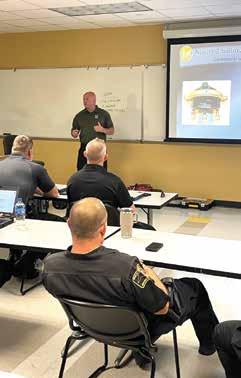

The Advanced Direct to Module Training for the SSS2 was a focused two-day program aimed at enhancing the skills of professionals working with HVEDRs. Members gained in-depth knowledge of the SSS2, exploring its features, functionality and practical applications in real-world scenarios.
Key elements of the training included comprehensive instruction on fault code management, where members learned to effectively identify, troubleshoot and eliminate fault codes. The curriculum also emphasized the development of loadable files
tailored specifically for the SSS2, alongside best practices for maximizing the simulator's efficiency and effectiveness.
By the conclusion of the training, members emerged with enhanced technical capabilities and confidence in troubleshooting and utilizing the SSS2 in their respective fields, ultimately contributing to the advancement of their careers in heavy vehicle technology. This training represented a valuable opportunity for members eager to deepen their understanding and practical skills in modern vehicle event data recording technology.


Overall, the completion of this advanced training is a testament to the dedication and professionalism of NCSHP in prioritizing road safety and enhancing its investigative expertise in commercial vehicle crashes. Through such initiatives, NCSHP is better positioned to ensure the safety of roadways across North Carolina and improve overall traffic enforcement strategies. n
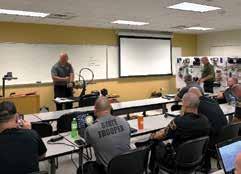
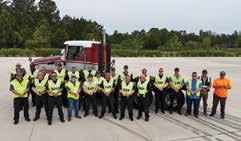
By Chief Troy Thompson, Office of Commercial Vehicle Enforcement, Florida Highway Patrol
On March 25, Florida Highway Patrol (FHP) members partnered with the Florida Department of Transportation (FDOT) to conduct the Battle of the Belts outreach at Fort White High School. On March 28, FHP and FDOT members conducted a similar outreach at Columbia High School. During the outreach, FHP members discussed best practices for operating around commercial motor vehicles (CMV), how to operate a vehicle safely, road rage and the use of safety belts while operating a vehicle. n

The FHP Commercial Vehicle Enforcement (CVE) unit teamed up with the International Fuel Tax Association (IFTA) and the Florida Trucking Association in Orlando, Florida, on June 4 for a presentation at the IFTA Educational Forum. Lt. Artez Lester and Lt. James Hightower gave an overview of FHP’s dyed fuel enforcement and radiological detection assets to more than 320 attendees from across the country who are involved with the IFTA program. n
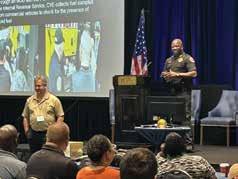
Since July 2024, 3-year-old Jr. Tpr. Lincoln, grandson of Sgt. Denise Meredith, has starred in multiple traffic safety messages on FHP social media platforms. Tpr. Lincoln’s first video centered around him learning about weigh station facility operations, discussing safety with CMV drivers and assisting FHP troopers with a Level I Inspection.
In July 2024, Tpr. Lincoln was featured on “Trooper Tuesday” with his black and tan CVE SUV and his K-9. In August of 2024, Tpr. Lincoln interviewed a school bus driver in Lake County. This video provided helpful tips to kids and drivers on the importance of school bus stop safety. In November 2024, Tpr. Lincoln teamed up with troopers Dowler and Estelus in a match with Belleview High School football players. The video described the stopping distance of a loaded truck. During the 2024 holiday season, Tpr. Lincoln traveled around central Florida, participating in Christmas parades with Tpr. Dowler. Tpr. Lincoln loves being a Florida Junior State Trooper. For May’s Share the Road Campaign this year, Tpr. Lincoln collaborated on a video with Tpr. Dowler to demonstrate the no-zone areas around CMVs. You can see Tpr. Lincoln’s public safety videos on Instagram and X by following FHP_CVE. n
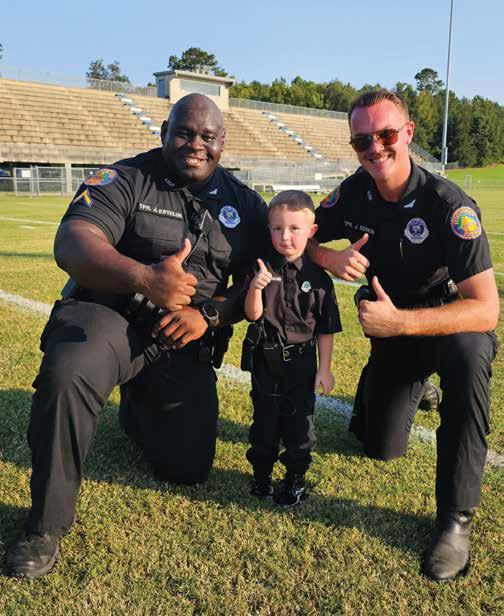
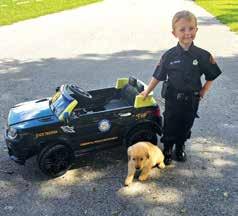
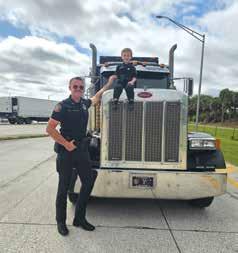

Continued on next page
Continued from page 13
On April 3, FHP conducted a CMV enforcement detail to remove unsafe vehicles and drivers from our roadways. The detail emphasized identifying criminal elements who have been pirating legitimate motor carriers’ names and USDOT numbers.
During the detail, members conducted 496 inspections, which resulted in 161 vehicles and 50 drivers being placed out of service. Two vehicles were identified as potentially pirating legitimate motor carriers’ names and USDOT numbers.
One of those traffic stops resulted in criminal charges. The second traffic stop resulted in a field interview for further investigation. n
On May 13, Maj. Thomas Pikul led a presentation on FHP’s human trafficking prevention efforts at the American Association of Motor Vehicle Administrators (AAMVA) Conference in Tampa, Florida. Maj. Pikul discussed FHP’s enforcement efforts with local law enforcement agencies, participation in CVSA’s Human Trafficking Awareness Initiative and combined efforts with partner states during our SafeDRIVE (Distracted-RecklessImpaired-Visibility-Enforcement) waves. Maj. Pikul further discussed the initiatives of FHP and its parters to conduct industry and public outreach and he shared resource materials available on CVSA's website. There were approximately 100 attendees at Maj. Pikul’s presentation.
Additionally, Lt. Artez Lester led a presentation on FHP’s efforts regarding Level VI Inspections and preventative radiological nuclear detection (PRND) at the AAMVA Conference. During the presentation, Lt. Lester
discussed the goals and strategies of FHP's hazmat/PRND program and the equipment used to complete mission assignments. There were approximately 30 attendees at Lt. Lester’s presentation. n
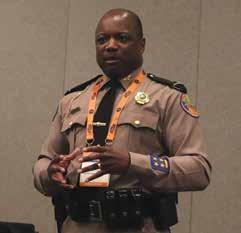
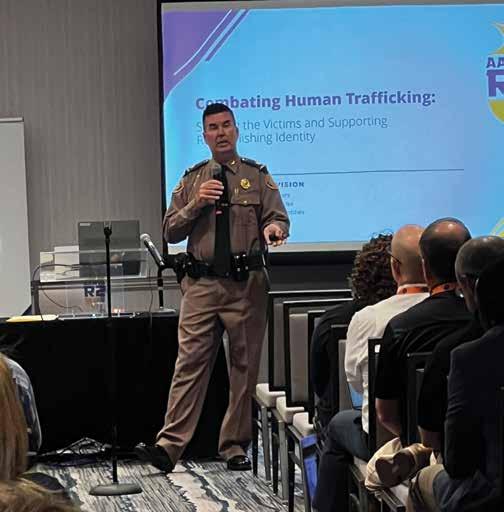
By Master Sgt. Victor McCarty, Public Affairs, Mississippi Commercial Transportation Enforcement Division, Mississippi Department of Public Safety
commercial
(CMV) has long been a factor in crashes on Mississippi roadways. In a forward-thinking move, the Mississippi Department of Public Safety’s (MDPS) Commercial Transportation Enforcement Division (CTED) has taken decisive steps to confront this issue head-on. Thanks to newly enacted legislation and advanced training initiatives, CTED is now enforcing speed and following distance laws for large trucks. This development is already making highways safer across the state.
Passed during the 2024 Regular Session and signed into law, House Bill 1015 marked a turning point for CTED’s enforcement authority. The bill authorized CTED inspectors to operate speed detection equipment and issue speeding citations to CMVs, expanding their role in promoting roadway safety. It also allowed CTED personnel to assist other law enforcement officers and administer breath tests, further aligning CTED with the mission of the Mississippi Department of Public Safety.
In the second quarter of 2025, CTED launched a comprehensive light detection and ranging (LIDAR) training initiative for its officers.
LIDAR offers precise speed detection that is ideal for large vehicle enforcement. With this new capability, inspectors can accurately measure CMV speeds and take action against dangerous driving behavior.
According to Federal Motor Carrier Safety Administration (FMCSA) data, speeding is a leading contributor to large truck crashes. The Large Truck Crash Causation Study revealed that driving too fast for conditions was a contributing factor in 23% of crashes involving large trucks. By empowering CTED officers to cite speeding violations, Mississippi is proactively working to reduce these numbers.
The speed detection equipment CTED has deployed includes advanced features beyond measuring speed. These units can also detect when vehicles follow one another too closely – a critical safety issue for heavy trucks. Following too closely is the second most common driver-related factor in fatal large truck crashes. FMCSA notes that truck drivers who tailgate limit their ability to stop in time and create dangerous chain-reaction collisions. CTED’s enforcement of following distance violations addresses this behavior before it leads to crashes.
The effort is not merely punitive; CTED’s strategy is rooted in public safety. FMCSA’s researchbased driving tips emphasize the importance of maintaining proper following distance, especially for heavy vehicles that require longer stopping distances. By enforcing these laws, CTED is aligning its operations with best practices that are proven to reduce crash risk.
CTED officers now serve not only as inspectors but as proactive highway safety professionals – trained, equipped and legislatively empowered to protect Mississippi motorists from the dangers posed by speeding and tailgating CMVs.
CTED’s expansion into speed and following distance enforcement is part of a broader culture shift in Mississippi’s approach to CMV safety. With strong legislative support, cuttingedge training and advanced enforcement tools, CTED contributes to Mississippi's public safety mission.
From highways crisscrossing the Delta to the interstates that carry goods through the Magnolia State, Mississippi’s roads are becoming safer, one citation – and one life saved – at a time. n
Continued on next page

Continued from page 15
Earlier this year, the Mississippi Highway Patrol (MHP) and CTED joined forces to complete an intensive Advanced Post-Crash Inspection Course certified by CVSA. This specialized training brought troopers and CTED officers together in a shared classroom, highlighting Mississippi’s commitment to interagency collaboration and continuous improvement in commercial vehicle safety.
The training, designed exclusively for law enforcement personnel, equips officers to conduct full forensic examinations of CMVs involved in crashes. This includes identifying mechanical defects, assessing contributing factors, and assisting crash reconstructionists and prosecutors with accurate, comprehensive evidence. Officers also learned how to
determine whether violations were preexisting or crash-induced – vital distinctions in both criminal and civil investigations.
What sets this training apart is its real-world impact. By improving the investigative capabilities of both troopers and inspectors, the program helps ensure that every serious crash involving a CMV is not only thoroughly examined but also contributes to long-term safety improvements on Mississippi highways.
“This training directly benefits the people of Mississippi,” said CTED Director Matt Lott. “It strengthens our ability to determine why a crash occurred and how to prevent similar incidents. It also reinforces the trust the public places in our commitment to highway safety.”
Driver impairment, including drug and alcohol use, was also a focus, aligning with FMCSA’s regulations on post-crash testing. The course prepared officers to document and respond to possible impairment, ensuring that impaired drivers are held accountable and that necessary follow-up procedures are initiated.
By completing this rigorous training, MHP and CTED have raised the standard for post-crash investigations in the region. More than just technical training, the course exemplifies a shared mission: protecting the lives of CMV drivers and the motoring public through diligent, informed enforcement. n

Criminal interdiction officers with CTED made a major drug seizure on May 29, during a routine CMV inspection on Interstate 22 in Lee County, Mississippi.
The stop involved an 18-wheeler car hauler registered in Oklahoma City, Oklahoma. The truck was en route to Florida, transporting a load of passenger vehicles. During the inspection, CTED officers noticed irregularities that prompted a deeper roadside investigation.
Upon further inspection of the vehicles on the trailer, officers discovered approximately 185 pounds of illegal marijuana concealed in the bed of a black pickup truck. A records check revealed that the black pickup truck had been reported stolen, raising additional red
flags in the investigation. The driver of the car hauler was immediately taken into custody and transported to the Lee County Detention Center.
This successful seizure is a testament to the vigilance and expertise of CTED officers, who are trained not only in CMV enforcement but also in advanced criminal interdiction tactics. Their work protects Mississippi roadways and helps prevent illegal drugs from reaching communities across the southeastern U.S.
The Mississippi Department of Public Safety continues to prioritize highway safety and criminal interdiction, working hand-in-hand with local, state and federal partners to ensure the safe and lawful movement of commercial traffic throughout the state. n

Approximately 185 pounds of illegal marijuana were concealed in the pickup truck, which had been reported stolen.
Continued on next page

Continued from page 17
The Mississippi Truckers Association hosted the annual Mississippi Truck Driving Championship May 2-3 in Gulfport, Mississippi. The event, organized by the Mississippi Trucking Association, brought together top-tier professional drivers and safety officials for a showcase of skill, precision and collaboration. Drivers competed in various categories, including pre-trip inspections, written tests and driving skills courses.
The MDPS CTED played a pivotal role in the event to ensure that safety remained the cornerstone of the competition. This partnership underscores the critical importance of cooperation between the transportation industry and regulatory bodies in promoting highway safety.
In addition to the driving competitions, the event hosted the 2025 MDPS Inspectors' Competition, where inspectors demonstrated their vehicle safety and compliance expertise. These competitions recognize the dedication of MDPS inspectors and emphasize their shared commitment to maintaining high safety standards on Mississippi's highways. CTED appreciates the efforts of training instructors Master Sgt. Kristen Beamon and Senior Staff Sgt. Level Walley Jr. for their outstanding work in organizing the Inspectors' Competition.
The collaboration between MDPS and industry professionals at the competitions exemplifies how joint efforts can lead to safer roads for all. By fostering strong relationships between drivers and inspectors, Mississippi continues to set a standard for highway safety and professional excellence. n
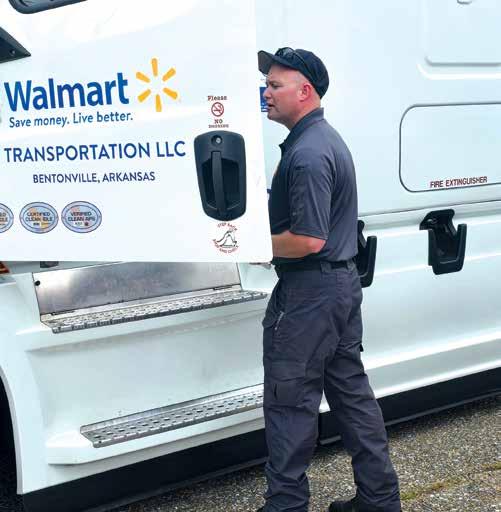
INSPECTORS' COMPETITION RESULTS:
1st Place: Sgt. Jaclyn Pendleton
2nd Place: Ofc. Tanner Moody
3rd Place: Sgt. Marquis Fisher
HAZMAT OLYMPICS RESULTS:
1st Place: Crimson Thunder
Team Leaders: John Williams and James Guthrie
2nd Place: Blue Fury
Team Leader: Keith Joseph (2022 Inspector Champion)
3rd Place: Emerald Green
Team Leader: Bradley Hogue (2024 State Competitor and National Attendee)




Presented by the Cooperative Hazardous Materials Enforcement Development (COHMED) Program, the COHMED Conference is a focused, one-of-a-kind event for individuals and organizations involved in the regulation, enforcement and safety of transporting hazardous materials and dangerous goods. Join us Feb. 2-6, 2026, in San Antonio, Texas, for the COHMED Conference.
To learn more, visit www.cvsa.org/events/ cohmed-conference. n

By Orlando Ortega, Commercial Vehicle Enforcement, Texas Department of Public Safety
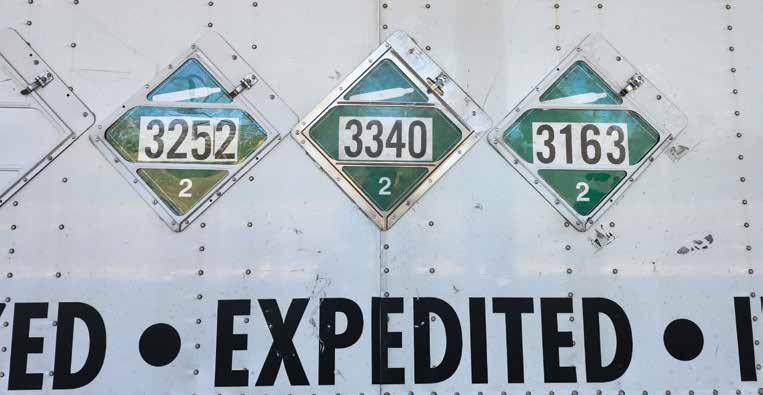
UN3252 Difluoromethane is a 2.1 flammable gas and was placarded incorrectly on each side and each end. The driver stated he thought all the hazmat products he was transporting were 2.2 non-flammable gas.
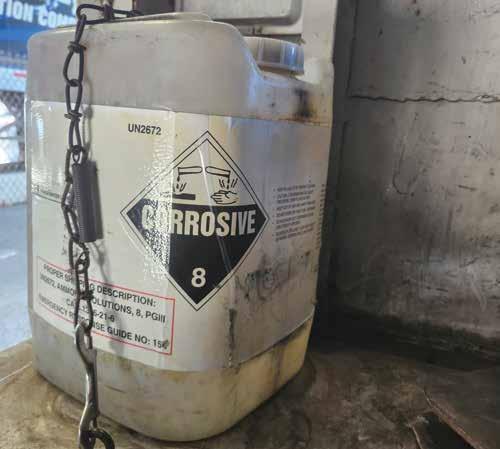
This container is displaying a label out of specification, per § 172.442. This package contained an ammonia solution.

The placard was water-damaged from a rainstorm during transport. The placard and incorporated marking are out of specification due to damage; see § 172.516(c)(6) and § 172.332(c).
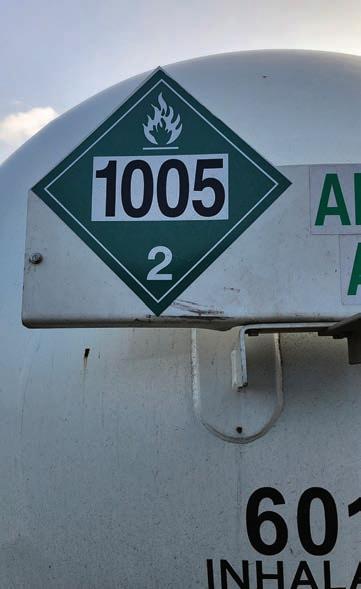
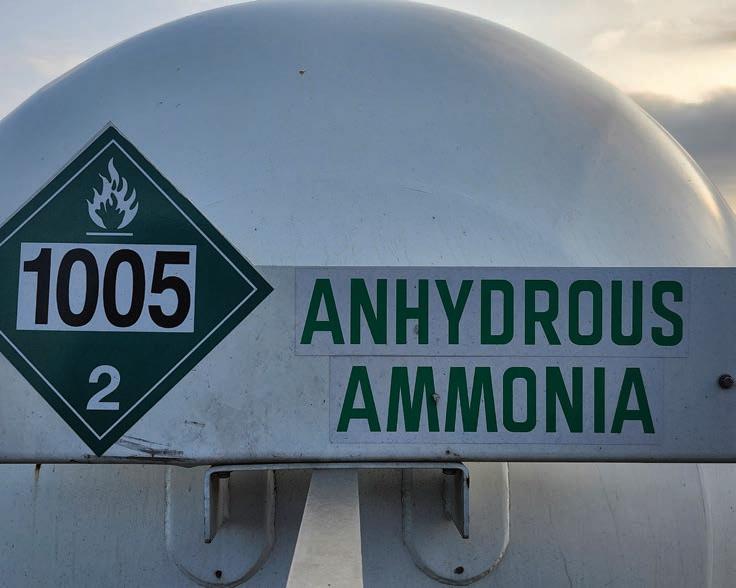
Anhydrous ammonia is a 2.2 non-flammable gas and requires a non-flammable placard. The placard has a flame at the top, which is incorrect. The non-flammable placard should have a cylinder at the top.
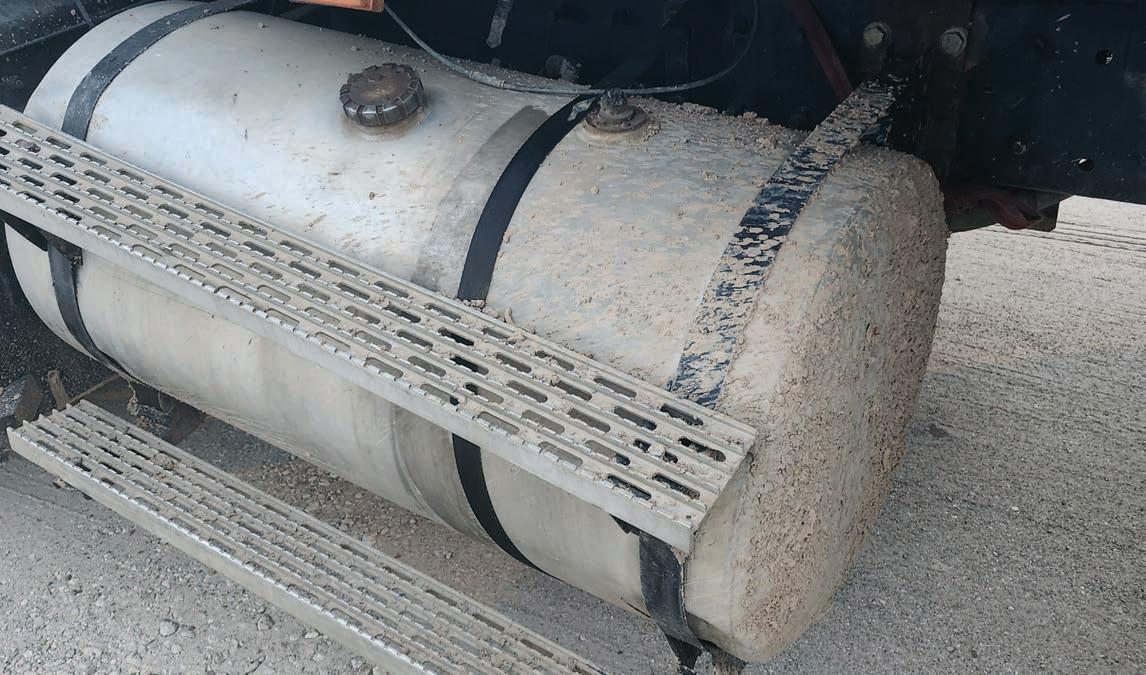

By Lt. Mike Maytum, Carrier Enforcement Division, Nebraska State Patrol
Imagine, if you will, the need to stop a fleeing vehicle. One option we have at the Nebraska State Patrol (NSP) is the Stop Stick, which has proven to be a valuable tool. Now, imagine that vehicle isn't just a passenger vehicle but a large commercial motor vehicle (CMV) – and it won't stop. What next?
The NSP Carrier Enforcement Division was challenged with that question a couple of years ago after a CMV pursuit traversed more than half of the state, refusing to stop. Stop Sticks were largely ineffective, and tactical vehicle intervention was impractical. We were challenged to find a better way. One of the tools we discovered was the Barracuda, a tactical tool similar to a Stop Stick but with features that make it effective on a large CMV.
The challenge of using traditional tire deflation tools is that the quills are narrow and not
terribly long. On passenger car and light truck tires, the quills can penetrate the tire and deflate it. As tire sizes increase, so does the available air that needs to escape the tire before it is flat. Additionally, the tires have many more plies, making quill penetration difficult. The design of the new tool involves much larger, more rigid quills that can penetrate the heavy truck tire. The unit is also self-uprighting, meaning the quills should always point upward, which assures correct deployment.
As part of the vetting process, it was determined that the agency should evaluate live testing of the equipment. The challenge became finding willing partners who would let us poke irreparable holes in their tires. Fortunately, the Carrier Enforcement Division maintains good working relationships with many of our Nebraska trucking industry
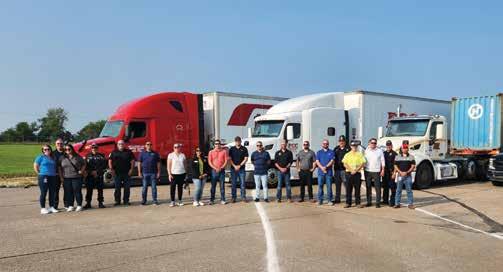
partners. Once the offer was made, several willing companies volunteered equipment and drivers to conduct the testing.
With several industry partners watching, we rolled three different trucks across the tool in a controlled environment. The results of that testing demonstrated its effectiveness in quickly flattening CMV tires, taking less than 30 seconds in each test case. The truck drivers all said the same thing: It would be nearly impossible to continue driving the vehicle once the steer tires were flat, which is the ultimate goal when deployed.
We owe our thanks to Crete Carrier, Transport Specialists Limited, Fremont Contract Carriers, Pomp’s Tire and the Nebraska Trucking Association for their assistance in making this testing possible. n


Motor carriers with oversized loads in Oregon have a new way to get the permits they need to ensure their loads are legal and safe. The Oregon Department of Transportation (ODOT) has streamlined the permit process by launching Oregon Routing Information Online (ORION).
ORION is a web-based, self-service permitting system provided by the ODOT Commerce and Compliance Division. It allows motor carriers to request over-dimension permits 24 hours a day, seven days a week, 365 days a year.
"ORION’s implementation is a priority in ODOT’s Strategic Action Plan, which calls for an efficient, innovative and technologically advanced transportation system,” said ODOT Commerce and Compliance Interim Division Administrator Carla Phelps. “The new permitting system has been years in the making and is an exciting development for the trucking industry in Oregon. We’re pleased to join 44 other states that have implemented similar modernized systems.”
ORION is a result of ODOT’s dedication to enhancing convenience and efficiency.
Benefits include:
Automated routing for trip planning and single-trip permits
Improved safety by reducing the risk of errors
Auto-issued permits for qualified loads Decreased wait times for obtaining overdimension permits
Timely notification of route closures or restrictions
The Oregon Trucking Association is also contracted to issue over-dimension annual permits for its customers.
All other Commerce and Compliance business transactions remain available through existing processes, including Oregon Trucking Online. ODOT contracted with ProMiles, a leading provider of over-dimension permit systems, to develop ORION. n


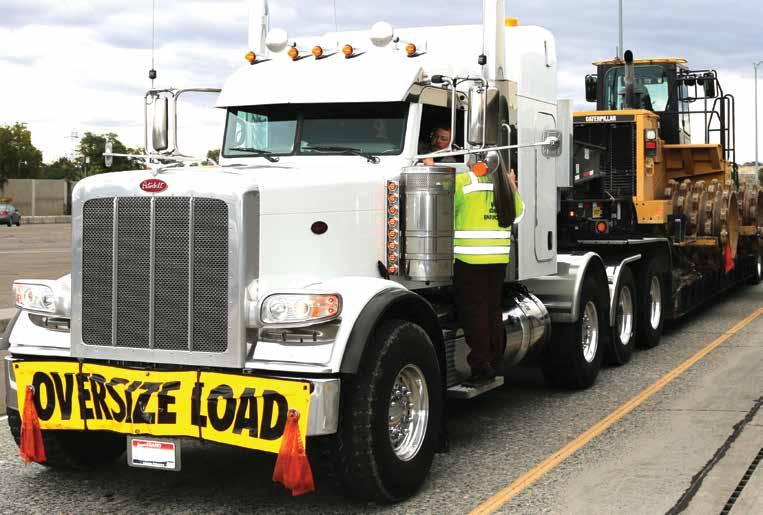
By Susan Chang, Motor Carrier Safety Manager, Hawaii Department of Transportation
The Hawaii Department of Transportation (DOT) Motor Vehicle Safety Office continues to be active in the Federal Motor Carrier Safety Administration’s mission of saving lives and ensuring safety on our roadways for everyone. Enforcing full compliance is one of our main goals as we strive for zero crashes and fatalities.
Hawaii participated in International Roadcheck from May 13-15, conducting inspections on the islands of Oahu, Maui and Kauai.
Vehicle inspections conducted: 96
Safety violations found: 135
Vehicles placed out of service: 15
Drivers placed out of service: 12
Citations issued: 18
In addition to the vehicle inspections, officers educated drivers on the 2025 International Roadcheck focus: tires and false records of duty status. Officers also emphasized the importance of safe driving behaviors on the roadways. n


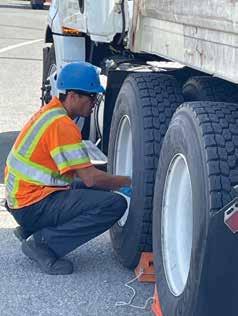
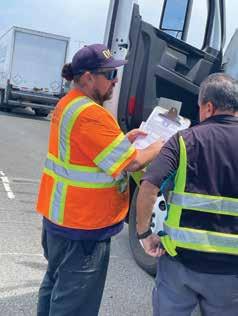


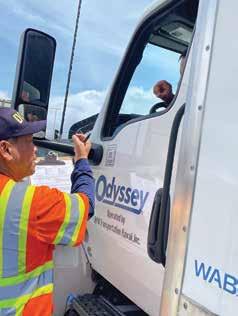
On March 10, Engineer Jesús Antonio Esteva Medina, secretary of infrastructure, communications and transportation, participated in the conference series "Dialogue with Engineers," organized by the Mexican Association of Civil Engineers (CICM). During this event, some of the most critical challenges and opportunities for the future of Mexico's infrastructure were discussed.
One of the highlights of his speech was the announcement of a new national aviation policy, designed to make the sector cleaner, safer and more efficient. This new policy will include measures such as the use of renewable energy, compliance with international standards and the strengthening of airport infrastructure and services – all with the goal of positioning Mexico at the forefront of global air transportation.
In addition, Esteva Medina acknowledged the fundamental role that the CICM has played in contingency situations and in developing technical solutions to address the country’s infrastructure challenges. CICM’s ongoing support has been key to building more resilient and modern infrastructure.
This effort is part of the Mexican government's commitment to promote more sustainable and competitive transportation, aligned with global trends and the policies advocated by organizations such as the Organisation for Economic Co-operation and Development and the International Transportation Workers’ Federation.
The event also served as an opportunity for Esteva Medina to detail the National Road Infrastructure Program 2025-2030, which will involve an investment of 173 billion pesos for more than 4,000 kilometers of roads.
Work is underway on 43,371 kilometers of toll-free roads and 10,614 kilometers of the Federal Toll Road Network. Together, these make up 54,000 kilometers of the Federal Road Network, for which the Ministry of Infrastructure, Communications and Transportation (SICT) is responsible for building and maintaining. Of these, 19,240 kilometers make up the 15 main corridors where most of the country's cargo and people travel.
Throughout the event, the importance of reinforcing technical ties with the CICM was emphasized. The aim was to improve infrastructure practices, adopt international standards to boost the sector's competitiveness and strengthen collaboration mechanisms to more efficiently address future challenges. n

On March 25, the National Gazette published an agreement to simplify regulations and services for regulatory improvement, aiming to modernize processes and the operation of services. These improvements may be expedited through general agreements on matters of federal motor transportation and preventive medicine.
The agreement includes the unification of two procedures: registration of motor transportation companies and registration modification. These were not substantively altered but rather had nonessential official documentation removed.
Regarding changes in protection and preventive medicine, three procedures were unified:
The Comprehensive Psychophysical Exam for Federal Public Transportation Personnel
The Comprehensive Psychophysical Exam for Revaluation of the Toxicological Test
The Comprehensive Psychophysical Exam for Revaluation of the Medical Exam in Operation
These updates allow medical personnel to request additional medical information as needed. n
From May 13-15, SICT, through the General Directorate of Federal Motor Carriers (DGAF), participated in CVSA’s International Roadcheck.
This year's operation focused on tires and false records of duty status. SICT deployed specialized personnel to fixed size and weight verification centers to carry out physical and mechanical inspections of vehicles providing public and private federal freight motor carrier services.
Inspections included detailed checks of critical systems such as lighting, steering, brakes, fuel, exhaust, suspension, chassis, wheels, rims, windshields and – as a priority this year – tire condition. Tread depth, proper inflation pressure and possible damage such as air leaks, tread separation, cuts, bulges or sidewall deterioration were all evaluated.
This coordinated effort is part of SICT’s ongoing actions to ensure road safety and compliance with the Official Mexican Standard NOM-068-SCT-2-2014, which establishes the physical and mechanical conditions that federal motor carrier vehicles must meet to operate safely. n
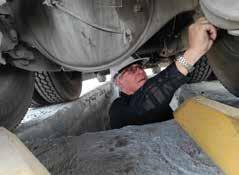


of an infraction ticket.
In May, SICT, through the Undersecretary of Communications and Transportation, published the new violation ticket format in the Official Gazette of the Federation. This document will be used by authorities during inspection and verification duties related to federal motor transportation, auxiliary services and private transportation.
The implementation of this new format represents a significant change within the current regulatory framework. It aligns with the Law of Roads, Bridges and Federal Motor Transportation as well as various regulations related to weight, dimensions, safety and the transportation of hazardous materials. It came into effect on June 27, officially repealing the previous format issued on Dec. 10, 2021.
The new format will be issued by authorized SICT personnel at key control points, including fixed verification centers, passenger and cargo terminals, airports, ports, and highways under federal jurisdiction. Its use will be mandatory during verification operations inspecting vehicle mechanical conditions, safety standards compliance, transportation of hazardous materials, and adherence to legal weight and size limits.
DGAF and SICT state centers throughout Mexico are authorized to carry out inspections, issue new violation tickets and apply sanctions in accordance with applicable legislation. These actions are conducted under the powers granted by Articles 23 and 41 of the SICT Internal Regulations.
SICT remains committed to informing and training all stakeholders in the transportation sector in a timely manner, promoting regulatory compliance as the foundation of a safer, more efficient and competitive logistics system in Mexico. n
The CVSA Workshop, held from April 27 to May 1 at the Hilton New Orleans Riverside in Louisiana, is a key event that brings together government authorities, law enforcement and transportation industry representatives from across North America. During this year’s workshop, the Mexican delegation, through SICT, highlighted significant progress in mobility, road safety and inclusion.
Director of International Motor Carrier Services
Claudia Franco represented Mexico and expressed SICT’s gratitude to the CVSA for the opportunity to participate. She extended greetings on behalf of SICT Undersecretary Tania Carro Toledo and SICT-DGAF Director General Luis Ruiz Hernández. She also gave special thanks to CVSA President Capt. John Hahn and CVSA Executive Director Collin Mooney for their kind invitation and hospitality.
Franco emphasized that since Mexico’s last participation in the CVSA Workshop, the commitment to improving federal motor transportation and road safety has been maintained. She highlighted actions taken in
compliance with the General Law on Regulatory Improvement, which mandates that all public policies focus on streamlining processes and services, under principles of legality, normative hierarchy and institutional efficiency.
In federal transportation, key changes were made to registration processes, merging the registration and modification procedures for individuals and legal entities into a single process. Additionally, the procedures for comprehensive psychophysical exams were unified. These apply to drivers of federal public transportation and ground support personnel and include specific medical evaluations such as post-accident assessments and toxicological tests.
One of the most significant topics addressed was the institutional response to complaints from the Federal Motor Carrier Safety Administration regarding irregularities in the issuance of federal licenses.
SICT, DGAF, Protection and Preventive Medicine in Transportation, and Information
and Communications Technologies conducted an exhaustive analysis of the reported cases. Using bilateral cooperation mechanisms, 68 license verification requests were addressed, irregularities were corrected and interagency collaboration was strengthened. Eight cases remain under document and technological review.
Finally, the Mexican delegation presented a regulatory update on road safety. As of Feb. 7, a visual identification system – or “balizado” (marking) – was implemented for federal transportation units. This measure includes the use of visible, reflective and durable characters (via decals or paint) to identify vehicles by type and configuration, reinforcing monitoring and control on federal highways.
Through its participation, Mexico reaffirms its commitment to regional cooperation, institutional transparency and continuous improvement in federal motor transportation services, fostering safer, more efficient and inclusive mobility for all of North America. n

By Jimmy Valenti, Cedar Hill (Texas) Police Department
Hello, my name is Jimmy Valenti (AKA JIMMMMMY), and I am a local inspector from Cedar Hill (Texas) Police Department. As I sit here in my squad car waiting for a truck to inspect, I am overwhelmed with the thoughts of the past week. Last week, I had the honor of attending my 15th CVSA event, the 2025 CVSA Workshop in New Orleans, Louisiana, and again, I was not disappointed. As the week ended, I talked with Emily Moorhead, the amazing editor of the awesome, informative and revitalized CVSA magazine, “Guardian.” While speaking with her, she planted a seed in my head of writing an article for the new local’s section of the “Guardian.” So here I go.
I, along with several hundred other people, spent the week learning, fellowshipping, contributing to committees and meeting new contacts from fellow law enforcement, industry and government, all to advance and maintain commercial motor vehicle (CMV) safety. Every day was filled with hard work from breakfast (on the house) to the end of the workday. It always amazes me how we can come together from all over the U.S., Canada and Mexico and function as one big family. We truly watch major work be planned and executed in one week, despite not seeing each other for four to six months. This work is done with precision, comparable to a major corporation comprising folks who work together daily.
As I think about all the accomplishments of the week, I consistently come back to the answer on how this can be done time and time again, year after year, conference after conference and workshop after workshop. The answer is the CVSA leadership and staff.
Executive Director Collin Mooney and Deputy Executive Director Adrienne Gildea have steered this ship in the right direction for many years. I often say to others that they seem to use Chick-fil-A's approach in hiring and assembling their staff and teams. For those who don’t know, Chick-fil-A is a chicken restaurant chain, and they seem to hire employees and assemble teams who smile all the time, say “my pleasure” constantly and genuinely make you feel good going there. They appear to love their jobs and enjoy working together. As I watch the CVSA staff work together, I often see them all smile, work hard together and use an all-hands-on-deck approach to the week. We have seen moves and changes – people coming and going in the Alliance – and somehow it still works.
The new people work, the old people work, the process works, and it all falls back to the two at the top. I mean, they take the best from enforcement, industry and the professional world and make them part of the team. I’ve also got to shout-out Director of Enforcement Programs Jake Elovirta, Director of Hazardous Materials Programs Bill Reese, Roadside Inspection Specialist John Sova, Multimedia Specialist Terry Moore, Traffic Enforcement Specialist Kevin Andrews and Roadside Inspection Specialist Jeremy Disbrow, and all I have to say is … WOW.
During the week, you will see Adrienne put out fires, guide, lead, advise and do whatever needs to be done. Collin also leads, advises and counsels, walking around with a regulations book in his hand while talking to someone. He goes from committee to committee, all the while knowing the key discussions taking place – not to mention, he’s incredibly approachable the whole time.
At 7 a.m., Multimedia Specialist Mark Mills will greet us at breakfast one minute and work a microphone the next. Director of Conference and Event Services Kristin Yednock will hand us our pretzels, change committee signs and let hotel staff know something isn’t quite right.
You’ll see Director of Compliance Programs
Katie Morton running a microphone in a committee and keeping a conversation going. Director of Inspection Programs Kerri Wirachowsky is getting hit from every angle by people just wanting to ask her a question or pick that brain of hers – and she takes it all in stride. I have not even mentioned the work of Manager of Meetings and Events Cassy Dafin, Certification Coordinator Paola Berridi, Training Coordinator Amy Molina, Learning Management System Specialist Annie DeGennaro, and Manager of State and Local Contracts David Findlay and all the work they do from early morning to late at night. I am sure I forgot some, and I am sorry if I did, but they all do this with smiles on their faces, all for us, the members.
The CVSA Board of Directors, Executive Committee, Finance Committee, region and local member leadership, committee and program chairs and vice chairs, local and associate member presidents and vice presidents – all the leadership from the top down – work together toward one noble mission: to prevent CMV crashes, injuries and fatalities throughout North America.
For those local, state, federal and industry personnel, along with all the others that read this magazine, if you have not attended an event, please check it out for yourself to see what I am talking about. See what goes into that Out-of-Service Criteria Handbook that you use daily in your profession. If you attend, you will also have the privilege of having a part in the future of the Alliance, along with meeting new peers and lifelong friends. Come see where the rubber meets the road, where it all starts and ends – with the Commercial Vehicle Safety Alliance. n
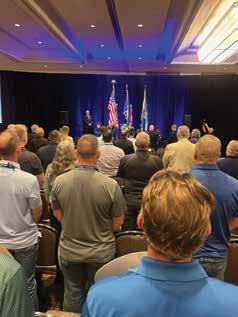
By Christopher Vinson, Midlothian (Texas) Police Department; CVSA Local Member President
On behalf of the CVSA Class II Local Members, we would like to congratulate two of our best on reaching retirement and recognize their service to law enforcement and CVSA.
Ofc. Thomas Mrozinski served 32 years, retiring from the Frisco (Texas) Police Department, and Ofc. Lincoln Sweeney served 21 years, retiring from the Cedar Hill (Texas) Police Department. Both men have been consistently committed to highway safety through commercial motor vehicle enforcement and represented the local member inspector community well through their leadership as former CVSA Class II Local Member presidents.
You both have paved the way for locals to become more involved and serve in greater capacities, cementing a more impactful future for local inspectors who come after you. Thank you, gentlemen, for your service and friendship. n

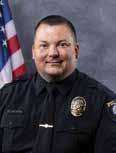


By Thomas Durham, Traffic Enforcement Unit, Buckeye (Arizona) Police Department
Officers from the Buckeye (Arizona) Police Department (PD) and Goodyear (Arizona) PD traveled to Flagstaff, Arizona, to participate in International Roadcheck. Ofc. Demaro with Buckeye PD recently finished his supervised inspections and is now starting his independent inspections. Ofc. Webster with Goodyear PD recently passed the hazmat course and was working on her supervised inspections during the detail. n


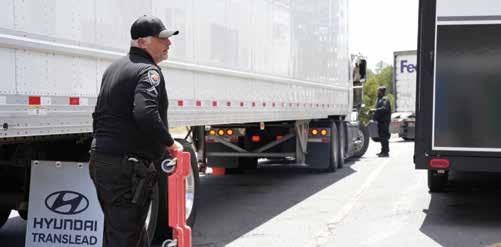
By Christopher Vinson, Midlothian (Texas) Police Department; CVSA Local Member President
Earlier this month, while attending the DallasFort Worth Council of Safety Professionals Meeting, I was honored by the presence and story of two legends who just happened to be in attendance. These two are some of the most intelligent and most humble men you could ever meet, and they represent everything we should aspire to achieve in our careers. This is a story that time must remember, as this is what the relationship between enforcement and drivers should look like. These two light up whenever they are together, as if they are family, and time stands still between encounters.
Charles “Chuck” Longfellow, whom we all know as “The Legend,” started his career with the Texas Department of Public Safety (TXDPS) in 1972, transitioning into license and weight –now commercial vehicle enforcement (CVE) – in 1977, when he was assigned to Amarillo, Texas. Gary Black started his driving career hauling grain for Hughes Elevator in Panhandle, Texas, in 1976. Gary says that Chuck was the first license and weight trooper to stop him when it was normal to run at 100,000 pounds because the fine was only $28.50. Chuck says that Gary was one of the drivers in the area he came to know as a professional.
Gary always talks about the 237 horsepower Mack five-speed he drove then, but he was happy as could be because he was driving a truck. He has since driven an impressive 5 million miles, even serving as one of Walmart’s
Road Team Captains. Chuck graduated from recruit school in 1972, spent five years on the highway patrol, and transferred to license and weight in 1977 to start what has been nothing short of an incredible career.
Chuck was working when Texas adopted the Federal Motor Carrier Safety Regulations and has worked through the many changes in both law and technology through the years. Life experience has made him one of the most knowledgeable inspectors working. Chuck became a North American Standard Inspection Part B instructor in 1990, later becoming one of the first instructors to start the TXDPS CVE Training Unit, where he could share his wealth of knowledge and experiences with inspectors nationwide. Chuck has become widely known as the expert and the go-to guy for all things vehicle and equipment. I can only hope to learn half of what Chuck has forgotten. He always has a smile and can brighten even the saddest days with his friendly demeanor.
When these men talk about each other, they both use words like professional, courteous and modest. Overall, each emphasizes the word humble to describe the other. Gary said Chuck is everything a law enforcement officer should be, with his humility, knowledge and professionalism – and I can’t agree more.
I had the privilege about a year ago to stop Gary for a roadside inspection, and I would say the same is true for him as a driver. He is one
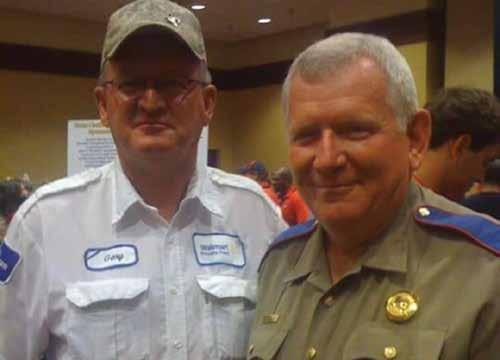
of the most professional drivers I have ever encountered roadside. They described the days when drivers and troopers were friends and had a mutual respect for what each other did. Gary told of a time when they would exchange caps and dash magnets to represent their professional relationship, and this particular relationship has stood the test of time for almost 50 years.
Both men represent the best of our industry in their respective fields and are an inspiration we should all strive to emulate. If you know either or both of these men, please thank them for their service and contributions to professionalism and highway safety. I thank you both for your friendship and the impact you have made. n
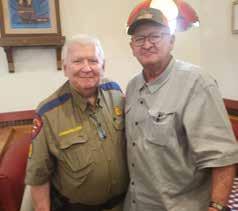


By Alexis Crockett, Commercial Vehicle Enforcement, Garland (Texas) Police Department
Picture this: It’s April 12. The day has finally arrived. Many months, days and long hours have gone into planning for this moment. Meetings, phone calls, office visits, handshakes, coordination and collaboration with all involved parties have taken place during the months leading up to this event. Today, the DallasFort Worth Council of Safety Professionals will witness the fruit of their efforts and will know at the event’s culmination whether or not their undertaking is a success. What is the event? It is the Dallas-Fort Worth Council of Safety Professionals Regional Truck Driving Championship.
For the last four years, the regional Truck Driving Championship (TDC) has been held in Garland, Texas. The Garland Independent School District has graciously provided the venue for the event each year. It had been held at Williams Stadium for three years, and in 2024, the last year at this venue, we were bursting at the seams. In November 2024, the council was made aware that Williams Stadium would no longer be an option due to the construction of the new Garland High School. Luckily, there was another viable option. Contact was made with the school district, and permission was granted to hold TDC at Homer B. Johnson Stadium, which was a much larger venue. This venue would accommodate the 200+ truck drivers, their families, participating
companies, sponsors, judges, spectators, dignitaries and more than 30 pieces of equipment.
The day before the event, the course had to be set up. Members from the council, the Texas Trucking Association, the Texas Department of Public Safety (TXDPS) and the Garland Police Department (PD) all converged on Homer B. Johnson Stadium to accomplish this. The traffic unit of the Garland PD graciously provided 200+ cones for the driving course and its boundaries. As equipment from FedEx, H.E.B. Groceries, XPO Logistics, ABF Freight Systems, Old Dominion Freight, Martin Bower, Walmart, Builders First Source and Bruckner’s Truck and Equipment arrived, it all had to be placed and positioned around the course. Trucks and trailers from one company were separated and attached to trucks and trailers from other companies. Then the pre-trip inspection course had to be put together and violations created on each piece of equipment for use during that portion of the competition. The written examination section had to be organized under a covered section of the stadium near the concession stand, and registration packets had to be completed. Barricades and trash cans provided by the City of Garland were placed all around the venue. Party tents for the participating companies were brought in and set up. Other participants showed up


throughout the setup process to claim their spots.
The event was scheduled to start at 8 a.m., but when I pulled up to the stadium entrance at 6:30 a.m., I could see that the parking lot was about 80% full. The stadium and its lights acted as a backdrop to all the parked cars. Before the start time, cars were parked along the driveway entrances to the stadium. Anyone coming to or just driving by could tell this was going to be a huge event. Last-minute tweaks were still being made before things kicked off. It was coordinated chaos, and everything needed to be just right.
The Garland Citizen Police Academy (CPA) sent ten of their alumni to help run water and score cards to the judges and volunteers throughout the day. The CPA alumni have always been willing and ready to step in to help make TDC a success, and their participation is very much appreciated. Commercial vehicle enforcement officers from all over North Texas had arrived and were ready to get to work. Officers from Garland PD, Arlington PD, Mansfield PD, Ft. Worth PD (jurisdiction of 2024 North American Inspectors Championship Grand Champion Jared Koester), Wylie PD, Mesquite PD, Grand Prairie PD, Richardson PD, Midlothian PD, Rowlett PD and TXDPS all volunteered their time to help make the event a success.

takes a great deal of work to prepare trucks for the pre-trip inspection portion of the competition.
Transportation and safety directors from the Dawn Foods Garland location and the City of Garland Water Department also took time out of their schedules to attend the event. They were given guided tours of the event station and explanations on how they were graded. The officials from Dawn Foods were so impressed that they stated they would participate in upcoming events. The safety director from the City of Garland took time to watch the pre-trip portion of the event and actually took part in it by attempting to locate a few of the staged violations himself. He, too, was impressed and spoke of putting together an event of this type for his drivers, with the hope of sending the top drivers to compete in TDC. Although I did not see them, a very seasoned, grizzly fireman told me the Garland city manager and a councilman stopped by.
The Garland Independent School District (GISD) has a large fleet of commercial motor vehicles, and they provided two of their five high school band 18-wheelers for the event. The Garland High School and South Garland High School trucks and 53-foot trailers were used as a backdrop for the course and the judges' stand. Both trailers were beautifully wrapped with their respective school logos and colors. They put on a remarkable showing for all in attendance. The director of transportation was impressed by the photographs sent to her and stated that
she wanted to create an internal policy that would make it easier for the council to use their vehicles for this event in the future. She said, “It makes GISD look good, and we appreciate that.”
Along with recognizing and celebrating some of the best drivers in North Texas, the council also wanted to make this event a fun, familyfriendly event. The Garland Fire Department provided a fire truck and a driver for the event. The fire truck was parked at the west end of the driving course in view of all in attendance. Parents brought their children over to get a guided tour of the truck by the seasoned, grizzly old firefighter who shall remain nameless because he knows my work address. The firefighter was seen throughout the day visiting trucking company tents, walking the venue and handing out stickers to the younger crowd. Later during the event, he expressed his surprise at how large it actually was. He went on to comment that it was much more than what he expected and asked that I make sure he is invited to next year’s event. This is a common theme I hear from those new to the experience of TDC.
The Texas Department of Transportation provided a team of experts in roadway safety education. These individuals handed out educational information on work zone safety, seatbelt usage, alcohol awareness and
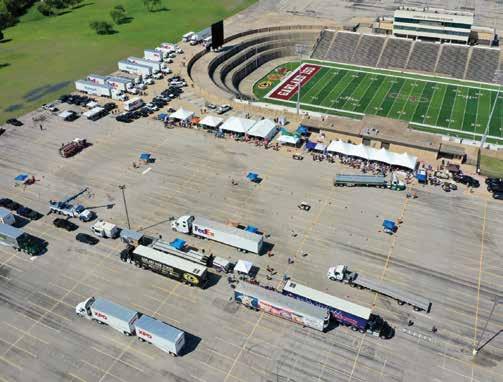
distracted driving to the competitors and their families. Like the fire truck, this was a huge success and greatly appreciated. They were able to reach out and speak with approximately 800 people throughout the day.
The Garland Police Never Walk Alone Foundation, whose mission is to assist members of the Garland PD and their immediate families in times of medical and mental health needs, provided a hot lunch to approximately 100 judges and volunteers. They also provided a hot lunch for the FedEx family. Please visit their website at www.garlandpolicefoundation.org to learn more about their mission.
After a very long day, 27 drivers from nine different truck classes were selected to move on to the state truck driving championship with the chance to compete at nationals. The Dallas-Fort Worth Council of Safety Professionals achieved their goals of hosting a top-notch community-oriented event and bringing awareness to the awesome drivers in the transportation industry. In doing so, they gained a few more allies from both industry and government. It only gets bigger and better from here. n
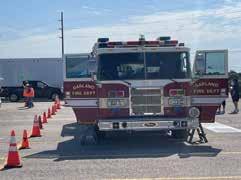

By Christopher Vinson, Midlothian (Texas) Police Department; CVSA Local Member President
The 2025 Texas Challenge was held in Corpus Christi, Texas, from June 2-4. State inspectors competed against each other to determine who would advance to the North American Inspectors Championship (NAIC) to represent Texas, and local inspectors competed against each other to determine who would be the CVSA Class II Local Member representative at NAIC.
After a tight competition, Harris County Sheriff’s Deputy Maurice Bucklin won first place among the Texas local members and advanced to compete at NAIC. Ofc. Ed Clark with the Carrollton Police Department (PD) placed a very close second. Additional local competitors included Sgt. Paul Tong with Irving PD, Ofc. Justin Scott with Houston PD, Ofc. David Driskill with Austin PD, Ofc. Travis Skinner with Midland PD and Ofc. Nathan Holsey with Fort Worth PD. All competitors had to advance from a regional competition to qualify for the state competition.
Congratulations to all participants – your drive and dedication inspire future leaders in commercial motor vehicle enforcement. n

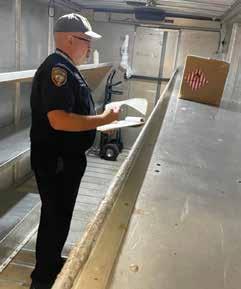

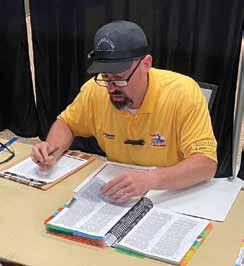

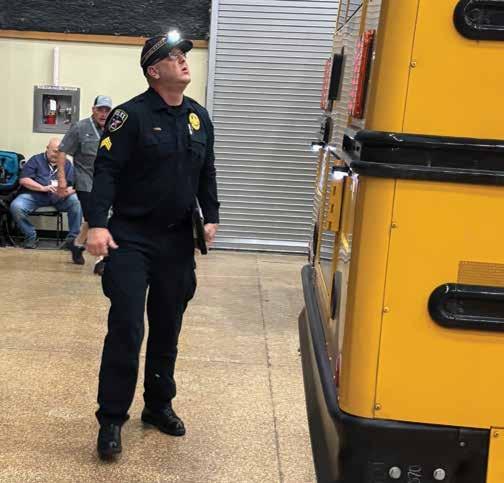
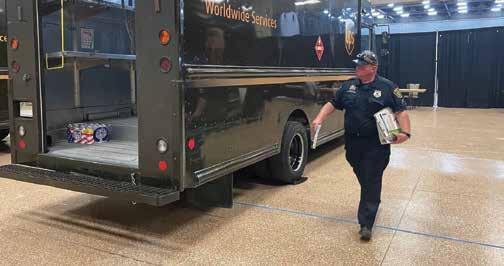

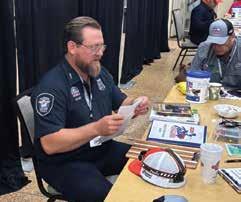





By Deputy Tyler Van Wormer, Clackamas County (Oregon) Sheriff’s Office
Since its inception in 2020, an interagency initiative has been quietly reshaping how commercial motor vehicle (CMV) enforcement is handled in northwest Oregon, which has not been done in the state before. What began as a collaborative effort between the Clackamas County Sheriff’s Office and the Washington County Sheriff’s Office has evolved into a monthly inspection operation involving multiple agencies led by the Clackamas County Sheriff’s Office.
Clackamas and Washington counties border Portland and are two of the most populous counties in Oregon. Recognizing a gap in traditional roadside inspections, the sheriff’s offices came together to target high-volume truck corridors just off major interstates, where CMVs typically pass without inspection or weighing.
Over the years, the operations have expanded to include weighmasters and safety investigators from the Oregon Department of Transportation (ODOT) and the Clackamas County Department of Transportation, as well as officers from the Oregon City, Molalla and Beaverton police departments. Together,
the operation has created an enforcement and education model that is mobile and collaborative. This has led to dangerous motor carriers being addressed quickly and, on occasion, compliance reviews being initiated by ODOT safety investigators on the spot. It has also brought equipment and technology together to address the varying needs of inspections.
Each month, the operation is set up in a different location in Clackamas or Washington counties, generally in areas with a steady flow of commercial traffic but little formal oversight. Portable weigh stations are deployed, and CMVs are flagged off the roadway for safety inspections and weight compliance checks.
The goal is to focus on the trucks that aren’t getting checked normally and ensure enforcement is taking place in areas that need it the most.
Alongside mechanical and weight inspections, the team conducts traditional traffic enforcement. Deputies and officers target moving violations such as speeding, distracted
driving and improper lane usage, which are common causes of serious crashes involving CMVs.
While enforcement is part of the operation, education is equally important. Inspectors take the time to speak with drivers and carriers, providing updates on safety regulations, weight restrictions and permit requirements.
What sets this operation apart is its adaptability. Beyond traditional inspections, the team actively monitors emerging trends and designs targeted enforcement efforts in response.
In recent years, that’s meant everything from sting operations on illegal household goods movers and unlicensed truck operators to working directly with the trucking industry in innovative ways. In one operation, recognizing that passenger cars statistically are the “at-fault” party in crashes involving CMVs, a deputy rode in the passenger seat of a semitruck to observe reckless driving by passenger vehicles around CMVs. The deputy called out violations by radio to other officers

stationed nearby, who pulled the offending drivers over. This gives law enforcement an additional perspective of what truck drivers see and shows the team’s goal is overall roadway safety.
In March, the City of Happy Valley, south of Portland, was chosen as the operation location. Inspectors used a church parking lot to flag in trucks. During this operation, a stolen vehicle was recovered, and numerous unlawful motor carriers were identified, including one who was hauling a regulated commodity for-hire without a USDOT number, operating authority, insurance or proper registration. The driver in this case was issued citations and was also provided a packet of information on how to become compliant. In addition to many trucks being placed out of service, an even higher number passed inspections with no violations.
Each monthly operation is also an opportunity for interagency learning. Inspectors and officers bring unique expertise and can share knowledge. The agencies also participate in an annual inspection training refresher, ensuring consistency and professional development across the board.
Though the program is just five years old, its impact is already being felt. From increased safety compliance to reduced crash rates and stronger relationships with the trucking industry, the monthly operations prove that collaboration works. ODOT statistics from just one year show a vehicle out-of-service rate of 24.5% and a driver out-of-service rate of 10.4%. In contrast, the national vehicle rate is approximately 20% and the national driver rate is approximately 5.6%. The team has also removed drivers from the road who are in possession of drugs. One driver was so fatigued that they fell asleep during the inspection.
This is about being proactive, not waiting for crashes to happen. The interagency team is out every month, doing the work that keeps roads safe, trucks compliant and everyone moving forward. n
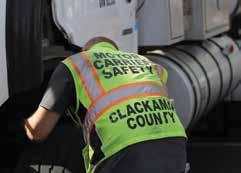

By Christopher Vinson, Midlothian (Texas) Police Department; CVSA Local Member President
Ofc. Jimmy Valenti of the Cedar Hill (Texas) Police Department and Ofc. Casey Knowles of the Mansfield (Texas) Police Department recently teamed up for an educational Level I Inspection detail in Grand Prairie, Texas. They worked with industry members to teach them about what inspectors look for in an inspection and to address their questions. n

By Ofc. Kyle Jahns, Commercial Vehicle Enforcement Unit, St. Louis County (Missouri) Police Department
On May 5, the St. Louis County (Missouri) Commercial Vehicle Enforcement Unit partnered with the Missouri State Highway Patrol to conduct a bypass detail at the westbound I-70 scale house in Foristell, Missouri. During this detail, officers from St. Louis County found more than 100 violations, with over 25 of those being out-of-service driver or vehicle violations. n
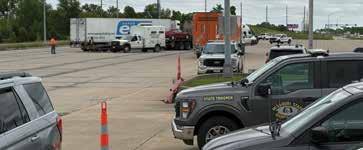
By Ofc. Derek Malena, Commercial Vehicle Enforcement, Allen (Texas) Police Department
Sgt. Bryan Kile of the Melissa (Texas) Police Department (PD) completed his initial 32 supervised inspections and is now ready to hit the highway on his own. Melissa is a growing community just north of Dallas with several miles of U.S. and state highways running through it. Sgt. Kile received assistance with his inspections from myself and Tpr. Michael Landeros of the Texas Department of Public Safety. n

By Christopher Vinson, Midlothian (Texas) Police Department; CVSA Local Member President
I would like to submit a huge thank you to the folks behind the scenes. Without Ken Carr, the “man behind the camera,” we would not have these great memories to share from all the CVSA events, including Workshop, the Annual Conference and Exhibition, and the North American Inspectors Championship. It really is amazing how he can be everywhere at once and capture all the great moments, silently slipping into the meetings with no disruption at all. To this absolute professional and gentleman – thank you.
And to the amazing ladies in the picture – especially Kristin and Cassy – none of this would have happened without all your collaborative hard work. I can’t begin to imagine the job ahead of these events and the amount that happens behind the scenes. Yet you keep a smile and always have an answer when we get lost. This team of awesome ladies deserves a great big thank you for doing their part in roadway safety. n
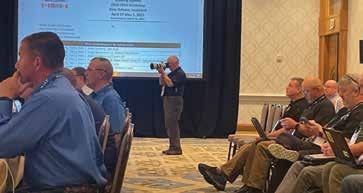
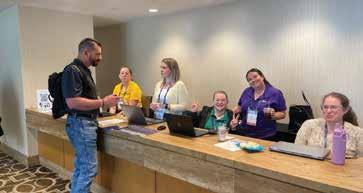
to
CVSA Certification
of Conference and Event Services Kristin Yednock, CMP, DES.
By Christopher Vinson, Midlothian (Texas) Police Department; CVSA Local Member President
In April, a Level VI recertification class in Austin, Texas, brought together two CVSA Class II Local Members who both won the Jimmy K. Ammons Grand Champion Award at the North American Inspectors Championship (NAIC). Ofc. Rommel Garcia of the Houston (Texas) Police Department was the first local member to win NAIC in 2017. Ofc. Jared Koester of the Fort Worth (Texas) Police Department is the reigning grand champion at the time of this writing.
It was really meaningful to see them learning together – and it’s proof that the champs never stop learning. Thank you for your leadership, gentlemen. n
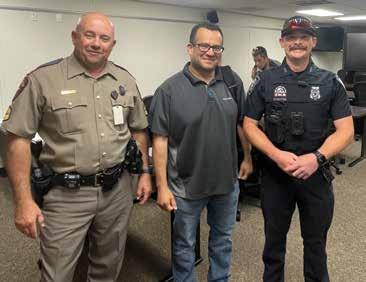
By Ofc. Derek Malena, Commercial Vehicle Enforcement, Allen (Texas) Police Department
The following combination of decommissioned school buses was spotted in Allen, Texas, southbound on U.S. Route 75 headed to El Salvador. At first glance, any commercial motor vehicle (CMV) inspector would know “that ain’t right.” As the combination continued down the highway, the rear bus swayed back and forth as the driver could barely hold it between the lane lines.
During the inspection, the inspector discovered that a Salvadoran transportation company was paying the driver to get the combination to the U.S.-Mexico border in Texas so another driver could take them to El Salvador.
Numerous things went wrong with this attempted drive-away/tow-away operation.
For starters, the front bus had a makeshift pintle hitch bolted only to the rear bumper
• § 393.71(d)Bumper tow-bars on heavy vehicles prohibited – Tow-bars of the type which depend upon the bumpers as a means of transmitting forces between the vehicles shall not be used to tow a motor vehicle weighing more than 5,000 pounds.
Next, the rear bus had a homemade tow bar consisting of a 2-inch receiver tube fastened to a steel plate with a large hole cut to resemble a pintle eye. The tow bar was connected to the bus frame with small fasteners. As you can see in the picture, the steel plate is already starting to wear and flare up from the hole. Being homemade, it was clearly not marked per the requirement.
• § 393.71(h)(9) Marking tow-bars – Every tow-bar acquired and used in drive-away/ tow-away operations by a motor carrier shall be plainly marked with the following certification of the manufacturer thereof (or words of equivalent meaning):
“This tow-bar complies with the requirements of the Federal Motor Carrier Safety Administration for (maximum gross weight for which tow-bar is manufactured) vehicles.”
Allowable maximum gross weight, manufacture month and year, manufacturer. Manufactured (month and year) by (name of manufacturer).
The driver also did not have a commercial driver’s license or record of duty status. These types of stops are why we do what we do as CMV enforcement professionals. Stay safe out there. n
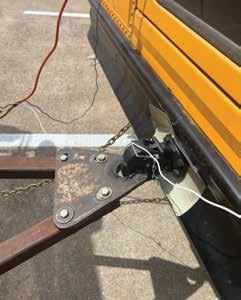


Drug-impaired driving is an escalating concern in the commercial motor vehicle (CMV) industry, posing significant risks to public safety. While alcohol impairment remains an issue, there are a growing number of CMV crashes involving drivers impaired by drugs or drugs in combination with alcohol. While data is often difficult to obtain (much like passenger vehicle drugged-driving crash data), the Federal Motor Carrier Safety Administration’s (FMCSA) Large Truck Crash Causation Study concluded that 87% of truck crashes are caused by driver-related factors, citing prescription drug use, over-the-counter drug use, illegal drug use and alcohol as four of the top 20 factors for large truck crashes.
Let’s examine the latest statistics on drug-impaired incidents, the impacts on law enforcement’s efforts and steps industry representatives can take to promote safety. We’ll also explore relevant news stories, public awareness strategies and how officers are working to address this dangerous trend through training and awareness.
Continued on next page
In a National Transportation Safety Board (NTSB) survey, 85% of all truck drivers surveyed reported that methamphetamines were readily available at truck stops. Another NTSB study revealed that approximately 35% of all truck drivers who die in truck crashes test positive for some kind of illegal drug. Of the truck drivers who are involved in crashes caused by fatigue, 33% tested positive for some kind of drug. This study concluded that in fatal-to-the-driver truck crashes, drug use by truck drivers is the second-highest contributing factor, with fatigue being the first.
A systematic review, titled “Psychoactive Substance Use by Truck Drivers,” revealed that the most common psychoactive substances for truck drivers were alcohol, amphetamines, cannabis and cocaine. In 12 studies that evaluated factors associated with the intake of psychoactive substances, the following stood out: younger age, higher income, longer trips, alcohol consumption, driving in the night shift, traveling interstate routes, fewer hours of rest, driver inexperience, connection with small- and medium-sized companies, productivity-based earnings, and prior involvement in crashes. The use of these substances was mainly associated with indicators of poor working conditions.
In this same study, researchers asked CMV drivers to respond to a survey about their drug use: Roughly half of the total respondents admitted to drinking alcohol while driving, and 30% admitted to using amphetamines. This study relied only on a driver’s admission of drug use. There are still relatively few scientific reports on the subject.
While data is limited on drug-impaired CMV driving, specifically, there is a plethora of data on drug-impaired driving, generally. Positive drug tests were found more often than alcohol among fatally injured drivers, according to the “Drug-Impaired Driving Report” released in 2017 by the Governors Highway Safety Association and the Foundation for Advancing Alcohol Responsibility.
Recent National Highway Transportation Safety Administration (NHTSA) studies have also found significant increases in drivers using cannabis or other drugs, leading to more drug-involved crashes. A review of fourth quarter 2020 data revealed that 56% of drivers involved in serious injury and fatal crashes tested positive for at least one drug. To compare, in 2015, 21% of all fatal crashes in the U.S. involved at least one driver who tested positive for drugs after the incident; in 2005, the rate was 12%.

Roadside drug and alcohol testing – and the technologies that make it possible –are current hot-button issues. The U.S. Department of Transportation’s (DOT) Federal Motor Carrier Safety Administration enforces a zero-tolerance policy for cannabis use or possession by commercial driver’s license (CDL) holders, regardless of state law. This creates confusion for drivers who may legally use cannabis off-duty but still face federal penalties if they test positive.
Additionally, current drug tests (i.e., urine and hair) detect past drug use, not necessarily current drug use. This is problematic roadside and at weigh/inspection stations, where officers need to assess real-time driver impairment to make enforcement decisions. Unlike alcohol tests (which correlate with impairment), no universally accepted roadside device has been determined to conclusively correlate active impairment from drugs like cannabis or cocaine. Oral fluid (i.e., saliva) tests for drug detection were approved by the U.S. DOT in 2023 but remain controversial; reliability, accuracy and contamination risks are debated, and motor carriers and law enforcement jurisdictions worry about false positives and/or legal challenges in court.
Drug use by truck drivers is the second-highest contributing factor in fatal-to-the-driver truck crashes, with fatigue being the first.
Finally, there is cross-border confusion for roadside testing. Canada uses saliva roadside screening for THC but requires lab confirmation before legal action. Mexico conducts random roadside drug tests, but the standards differ from U.S. DOT standards.
Roadside drug testing remains contentious because science, law, technology and policy are not yet aligned, putting CMV enforcement officers, drivers and motor carriers in an operationally difficult situation.
Because of this, many experts agree that underreporting is one of the most significant issues facing the industry. “It is widely believed drugged driving is underreported in all crash types,” explained Chris Turner, who leads CVSA’s judicial outreach. “One of the many problems in quantifying the number of alcoholand drug-related crashes is the frequency of testing. Nationally, most fatal crashes result in impairment testing of the fatal victim. However, many living drivers are not tested in fatal crashes or crashes where a fatality does
not occur. Because not all fatality victims or other drivers are routinely tested, we don’t have an accurate picture of the number of drug- and alcohol-impaired drivers.”
More information is soon to come, however. Turner added, “There is a current study with the Transportation Review Board and the National Academy of Sciences on the misreporting, under/overreporting of impaired driving – where drugs are the biggest issue of misreporting. The final report is being vetted now and will come out in a few months.”
Examples of drugs that some CMV drivers may take before and during shifts include:
Prescription medications: Prescription medicines are the largest category of drugs used among truckers, and data suggests this will continue to increase. Some CMV drivers obtain prescription drugs illegally, such as taking a relative’s Vicodin to treat back pain. Even when prescription medications are used legally and correctly, they can greatly affect a driver’s skills, alertness and reaction time.
Alcohol: Although drinking and driving is forbidden by law, some CMV drivers drink alcohol to cure boredom or cope with pain while driving. Alcohol is known to dull the senses, impair motor function and cause fatigue.
Cannabis: Research suggests that up to 20% of CMV drivers use cannabis regularly, and the figure may be even higher due to their reluctance to report illegal actions, even anonymously. Cannabis can impair the ability to drive because it may slow coordination, judgment and reaction times.
Stimulants: CMV drivers may use cocaine or methamphetamines/amphetamines to stay awake behind the wheel and log more miles. While these stimulants may increase heart rate and alertness, they can also cause hallucinations, lowered inhibitions and risk-taking behaviors, in addition to cardiac risks.
Unknown substances: Since most studies rely only on what drivers admit to taking, other illegal substances, such as LSD or heroin, are often underreported.
While each substance may have different effects on an individual, key effects of impairment on CMV drivers include reduced reaction time, impaired judgment, loss of coordination, fatigue and drowsiness, and decreased focus. According to NHTSA, using two or more drugs at the same time, including alcohol, can amplify the impairing effects of each drug a person has consumed.
CVSA Roadside Inspection Specialist Jeremy Disbrow shared a story from his time in enforcement: “There was a driver in Tucson, Arizona, who we received numerous 911 calls
about because he was all over the road. When I found him, he was driving on the dirt shoulder of I-10 and then weaving across multiple lanes of traffic at highway speeds. It took him forever to pull over, and when he stopped, he blocked the left lane of the interstate. The driver admitted to taking his prescribed hydrocodone and Ambien approximately an hour prior. He had no idea there was a problem because they were prescribed to him. The driver was arrested and charged with driving under the influence of drugs. Drugged driving is a hazard to every motorist – but this case was also unfortunate for the driver because he believed he was not breaking the law since his doctor prescribed it.”
FMCSA’s Drug and Alcohol Clearinghouse is a secure online database that gives employers, federal agencies, state driver’s licensing agencies (SDLA) and state law enforcement personnel real-time information about CDL driver drug and alcohol program violations. Additionally, Canadian and Mexican motor carriers who operate in the U.S. are subject to the Clearinghouse.
In the U.S., Clearinghouse data from the March report indicates that since its inception, 326,795 violations have been reported, with 319,159 attributed to drug use and 7,636 attributed to alcohol impairment. Continued on
Terry Kummer CVSA Crash Investigation Specialist

Slow speed (more than 10 mph under the speed limit)
Driving in opposite lane or wrong way, or wrong way down a one-way
Driving without headlights at night
Failure to signal or signaling is inconsistent with actions
Following too closely
Improper or unsafe lane changes
Weaving/weaving across lane lines, straddling a lane line
Stopping problems (too far, too short or too jerky)
Odors (alcohol, cannabis, other scents used to cover scents of the above, like perfume or cologne)
Lack of coordination, stumbling, tripping
Bloodshot or watery eyes
Pupil size: pinpoint or dilated
Sluggish, lethargic actions
Hyperactive, manic, wired
Repeating questions or comments
Swaying
Difficulty with vehicle controls
Speech (slurred, slow, fast, inaudible, not making any sense, grinding of teeth)
From 2020 through 2024, 295,818 drug tests have come back positive, with cannabis accounting for 58.8%, cocaine at 16.2% and methamphetamine at 8.4%. 2022 and 2023 have the highest number of positive drug tests across the board. However, while most positive tests across substances seem to decline somewhat significantly in 2023 and 2024, levels of cocaine use remain statistically similar. Trends show that cocaine and other stimulants may continue to be a problem for years to come.
Addressing drug-impaired driving requires a multifaceted approach involving training and public awareness. In addition to academy and ongoing training provided by jurisdictions, CVSA offers information on aspects of drugimpaired driving as a part of North American Standard Inspection Parts A (driver) and B (vehicle) and Post-Crash Inspection courses. Furthermore, the on-demand Interdiction Course, available on CVSA Learning, contains information about drug use and smuggling. Information and guidance on verifying a driver’s status based on data from the Clearinghouse can be found in CVSA Inspection Bulletin 2020-02 – Roadside Examination of Drug and Alcohol Clearinghouse Status.
In addition to the DWI Detection and Standardized Field Sobriety Testing (SFST) Basic Course all law enforcement officers receive, two additional modules teach officers the skills necessary to detect drug-impaired drivers: the Advanced Roadside Impaired Driving Enforcement (ARIDE) Program and the Drug Recognition Expert (DRE) Program. ARIDE is a 12-hour program that bridges the gap between the SFST Course and the DRE Program, which is a highly specific, rigorous program that requires 72 hours of classroom work, plus an estimated 40 to 60 field certification hours. Turner added, “The DRE Program is outstanding. I would recommend it to anyone who makes impaireddriving detection a career path.”
Public awareness campaigns aim to educate CMV drivers about the dangers and legal consequences of drug-impaired driving. CVSA's International Roadcheck is a prime example, where in 2024, more than 48,000 inspections were conducted. The driver focus area for 2024 was on alcohol and controlled-substance prevention. Inspectors issued 78 drug and 26 alcohol possession/use out-of-service violations throughout North America during last year’s International Roadcheck. In the
U.S., inspectors identified 63 drivers who were placed out of service for operating vehicles even though they were listed in FMCSA’s Drug and Alcohol Clearinghouse.
Jurisdictions are encouraged to run their own public awareness campaigns and engage in interagency collaboration to reach those in their area. In addition to outreach to and/or in collaboration with drivers/motor carriers, consider reaching out to local schools to educate children and teens on the dangers of drug- and alcohol-impaired driving.
If your agency or business has done outreach regarding drug- and alcohol-impaired driving, please consider submitting an article for consideration for future publication in this magazine. We work best when we share ideas with each other.
As drug-impaired driving incidents involving CMV operators rise across North America, the role of motor carriers and industry stakeholders has become increasingly vital in combating this public safety concern.
While enforcement officers are often the most visible part of the response, motor carriers and industry representatives play a central role in mitigating risks, enforcing compliance and supporting prevention strategies, serving as that critical first line of defense.
Since its launch in January 2020, the FMCSA Drug and Alcohol Clearinghouse has become a cornerstone of employer compliance in the U.S. The Clearinghouse maintains records of CDL drivers who have failed drug or alcohol tests, refused testing, or have not completed the required return-to-duty process.
Motor carriers are legally required to:
Query the Clearinghouse for all new drivers before hiring.
Conduct annual queries on all current drivers.
Report certain violations, including test refusals and actual knowledge of use.
Failure to do so can result in civil penalties and increased liability. Under Title 49 Code of
Federal Regulations Part 382, motor carriers must annually conduct random drug testing on at least 50% of their CDL drivers and random alcohol testing on 10%. These rates were reaffirmed for 2024 based on data showing that the industry continues to exceed the 1% positive test rate that would otherwise trigger reductions.
Experts warn that Clearinghouse checks alone are not sufficient. Motor carriers must go beyond the box-checking mindset. Substance use trends are evolving rapidly, and testing may lag real-time behavior.
Additionally, as of Nov. 18, 2024, the Clearinghouse II final rule requires the following:
SDLAs must query the Clearinghouse before issuing, renewing, upgrading or transferring CDLs and issuing, renewing and upgrading commercial learner’s permits.
SDLAs must review a driver’s information when notified by FMCSA of a driver’s Clearinghouse status change.
SDLAs are required to remove the commercial driving privileges of drivers in a “prohibited” status in the Clearinghouse, resulting in a downgrade of the CDL until the driver completes the return-to-duty process.
Training and Culture Matter
Many fleets have begun investing in driver wellness programs, peer mentoring and drug use prevention education to address impairment proactively. Others are revisiting company policies to ensure drivers understand the serious legal and career ramifications of operating a CMV under the influence of any controlled substance.
Routine Supervisor Training: Required by § 382.603, supervisors must be trained to recognize signs of drug and alcohol impairment.
Internal Notification Protocols: Some fleets maintain 24/7 reporting hotlines where dispatchers or coworkers can raise concerns about possible impairment.
Driver Support Programs: Some fleets provide confidential access to employee assistance programs that help drivers with substance use concerns return to work safely.
By focusing on early intervention, safety becomes a priority – and an essential company value.
These real-world incidents underscore the severe consequences of drug-impaired driving in the CMV industry.
This March, in Austin, Texas, a semitruck driver caused a catastrophic 17-car pileup. The CMV driver was found to be under the influence of central nervous system depressants at the time of the crash, which killed five people, including two children, and injured 11 more. Witnesses reported that the driver appeared drowsy, exhibited slow movements and appeared unusually calm for the circumstances, indicative of impairment. He was charged with multiple counts of intoxication, manslaughter and assault.
In Illinois, in 2024, an impaired dump-truck driver drove erratically for several miles before rear-ending a vehicle. The dump truck then crossed the center median, hitting a van and causing other vehicles to be struck in a multiple-vehicle crash. In a post-crash interview and field sobriety test, the driver smiled, laughed and stated he had snorted heroin. The driver had been involved in a hit-and-run earlier in the day, and he also had prior drug, alcohol and driving offenses. Two people died, one person was paralyzed and several others suffered life-altering injuries.
In 2016, Ofc. Vincent Smith, an 18-year veteran California Highway Patrol officer, was hit by a truck while clearing the roadway of a two-car passenger vehicle crash near Sacramento, California. Officers were attempting to move the vehicles onto the highway shoulder when Ofc. Smith was hit by the tractor-trailer, slamming him into a concrete bridge rail and causing life-threatening injuries. As a part of the investigation, a drug recognition expert conducted an evaluation, resulting in the opinion that the driver was impaired by a central nervous system stimulant. The driver was charged with possession of a controlled substance and admitted to investigators that he had dozed off prior to the crash. After spending several weeks in the hospital, Ofc. Smith was released to continue his recovery at home.
In 2016, on I-75 near Chattanooga, Tennessee, a tractor-trailer collided with multiple vehicles in a construction zone. The chain-reaction crash caused the deaths of six people, including two children. The initial investigation revealed that the CMV driver did not brake prior to the collision, and a drug evaluation discovered that the driver was impaired by Xanax and methamphetamine. In 2018, the driver was convicted on six counts of vehicular homicide and driving under the influence of drugs, resulting in an 83-year prison sentence.
OCTOBER 21-23
For more info, go to cvsa.org/events.

Continued from page 45
While this article does not endorse specific testing methodologies, motor carriers should stay informed about evolving drug testing tools, including saliva/oral fluid testing and expanded panel tests. Understanding what each test can and cannot detect – and within what time window – is essential for making informed policy decisions.
Canadian and Mexican motor carriers who operate in the U.S. are subject to the FMCSA Clearinghouse.
Canadian employers of commercial drivers must comply with federal regulations under Transport Canada, including mandatory drug and alcohol testing for cross-border drivers. As of 2022, Canadian federal law allows for salivabased roadside screening for THC. However, a positive roadside test triggers further lab analysis to determine impairment levels under the criminal code.
Despite state-level legalization of cannabis, FMCSA maintains a zero-tolerance policy for cannabis use and possession among CDL holders. This includes off-duty use in legal states. Any positive test for THC results in immediate removal from safety-sensitive functions.
In Mexico, commercial drivers are subject to national transport laws enforced by the Ministry of Infrastructure, Communications and Transportation. While Mexico does not have a Clearinghouse equivalent, police and federal authorities conduct random checkpoints, and impairment due to drug or alcohol use can lead to the suspension of commercial driving privileges.
Drug-impaired driving in the CMV industry poses a significant threat to public safety across North America. Through training and advanced enforcement efforts, the law enforcement community and the motor carrier industry are working diligently to mitigate this risk. Continued vigilance, education and cooperation remain essential in the ongoing battle against drug-impaired driving among CMV drivers. n
Use the FMCSA Clearinghouse consistently. Make pre-employment and annual queries standard procedure.
Invest in training. Train supervisors to recognize signs of impairment and create a reporting culture without stigma. Ensure drivers know the effects of prescription drugs on driving.
Stay current with trends. Impairment isn’t limited to alcohol, cannabis and stimulants –synthetics and prescription misuse are on the rise.
Foster a safety-first workplace. Make safety culture more than a slogan; tie it into every aspect of operations.
Collaborate with law enforcement. Build relationships with local law enforcement agencies to share intelligence and participate in safety campaigns.
New Mexico Department of Public Safety, Region IV

Hello, fellow CVSAers. Cory Ayon here, back on the road and running for CVSA secretary this fall. Looking back on the previous year and then some, we have had some new challenges and some old challenges introduced in our industry
When I say our industry, I mean exactly that: “our industry.” CVSA comprises a mixture of members ranging from regulatory agencies that oversee the development and implementation of new regulations; industry professionals like manufacturers, motor carriers and drivers that ensure the safe, efficient transportation of freight and services across our continent; and lastly, commercial vehicle enforcement personnel who educate, communicate and ensure compliance with regulations. Those who make up this body of like-minded safety professionals are just as connected as the highways and byways that connect our homes in the countries that make up our great Alliance: the U.S., Canada and Mexico.
In my over 30 years of service either to my country, the great states of New Mexico and Texas, or time spent in the private sector, the common denominator that I found, which holds our industry together, is people. I know it sounds cliché, but I feel that that fundamental truth binds us. Regardless of the country, agency or motor carrier you represent, it takes all of us to get it done.
One of the most rewarding things that I enjoy in my chosen profession is being an instructor. I currently instruct North American Standard Inspection Parts A and B, General Hazardous Materials and Cargo Tank Inspection. I recently added Level VI Train the Trainer to my toolbox as well. I honorably serve as a master instructor, working with and for fellow instructors to help them become better instructors. To take an inspector who knows little to nothing about commercial motor vehicles and instruct them on how to conduct an inspection is very rewarding, and I love to take my experience and pass it on to others to assist them in their chosen profession. Everything is an art until you figure out how it is done – and then it becomes a skill.
I am not going to try to razzle-dazzle anyone with a lot of buzzwords and canned verbiage to try to make myself out to be someone I am not. I served for two years as Region IV president, and anyone in that region will probably agree that when it comes to me, what you see is what you get. I was born to serve, and as your CVSA secretary, with your support, we can tackle any obstacles that come our way together. I
enjoy a challenge, and as your CVSA secretary, I will represent our organization to the best of my ability for years to come. Anything worth doing is worth doing right. Thank you for your support and your continued service. This is Cory Ayon, your friendly neighborhood tire kicker, saying, “Stay safe and stay professional.” I’ll be 10-10 on the side, ready to serve. n
Class I Member jurisdictions and Class II Local Membership will vote for secretary at the 2025 CVSA Annual Conference and Exhibition this September in Denver, Colorado.
Remember, when you cast your vote for secretary, you are electing a future CVSA president. The secretary position is a oneyear term, which transitions to a year as vice president, followed by a year serving as president, after which comes three years serving as past president.
Get to know this year’s candidates by reading the articles on pages 47-48, written by each candidate, which include information on their careers, philosophies on commercial motor vehicle safety and qualifications for serving as the next secretary of CVSA.

Iowa State Patrol, Region III

Hello, everyone. My name is Robert “Beau” Wittkowski, and I am honored to be a candidate for CVSA secretary in this year's election. For those I have not yet had the pleasure of meeting, I am from Iowa and serve as a trooper with the Iowa State Patrol. I reside in rural Marion County with my wife of 25 years, our children, two dogs and five chickens. In my personal time, I operate a tree and lawn care business, which allows me to spend much of the summer outdoors. When I am not working, I enjoy gardening and spending time with family and friends.
Prior to my career in law enforcement, I worked as an automotive and diesel mechanic. I had not anticipated that my mechanical experience would prove valuable in my current role, but I am grateful for the knowledge gained from working on trucks and
trailers, which has been instrumental when inspecting commercial motor vehicles and interacting with drivers. Additionally, working directly with drivers has provided me with firsthand insight that they are professionals dedicated to supporting their families, much like anyone else.
I bring over 20 years of law enforcement experience. I began my career as a reserve deputy and transitioned to a full-time role shortly thereafter, serving for nearly six years. Around the six-year mark, I applied with the Iowa Department of Transportation. In July 2023, the Iowa State Patrol and the Iowa Department of Transportation merged, and I am currently assigned to the Iowa State Patrol Training Team. I hold certifications in North American Standard Inspection Parts A and B, General Hazardous Materials Inspection and Cargo Tank Inspection, and I instruct courses for Parts A and B and Instructor Development Certification. I am also a certified master instructor and have been involved in instruction since 2016, which has allowed me to engage with professionals and build lasting relationships with people from the U.S., Canada and Mexico.
My first CVSA conference was a valuable learning experience, despite feeling initially overwhelmed by the numerous committees and attendees. I actively engaged in several committees and listened to discussions, which have greatly influenced my current
role as chair of the Vehicle Committee. I find committee work challenging yet rewarding, especially when collaborating with others and seeing tangible results that benefit CVSA inspectors nationwide.
If elected as CVSA secretary, my primary goal would be to support CVSA leadership in all safety initiatives and to mentor emerging leaders within the organization. I believe we must prioritize selecting passionate and qualified individuals to fill leadership vacancies and ensure that current leaders have access to the necessary resources and experience to succeed. I am committed to sharing my knowledge and experience with upcoming CVSA leaders at any time.
Throughout my law enforcement career, I have consistently aimed to provide positive interactions with the community. I hope my dedication to professionalism and service has been evident to those I have had the privilege to work with. I respectfully request your support and vote for CVSA secretary. Thank you for your consideration and stay safe. n

By Rodolfo Giacoman, Fatigue Management Specialist, Commercial Vehicle Safety Alliance
Can you spot the common denominators in these six crashes?
1. Collision of Motorcoach with Combination Vehicles Parked Along Exit Ramp to I-70 Rest Area
At 1:48 a.m. on July 12, 2023, a motorcoach carrying 21 people veered off I-70 near Highland, Illinois, colliding with three parked combination vehicles. Three passengers died. The driver and 11 other passengers sustained injuries of varying severity.
2. Combination Vehicle Rollover, Fire and I-95 Overpass Collapse
At 6:17 a.m. on June 11, 2023, a truck-tractor with a tank trailer carrying 8,500 gallons of gasoline crashed while exiting northbound I-95 in Philadelphia, Pennsylvania. The driver lost control on a curved exit ramp, causing the truck to overturn and strike a concrete barrier. The resulting fire destroyed the truck, caused the collapse of the northbound I-95 lanes and fatally injured the truck driver.
Box Truck Centerline Crossover Collision with Bus
At 6 a.m. on Jan. 28, 2023, a bus and a box truck collided head-on on New York State Route 37 in Louisville, New York. The truck crossed the centerline, striking the bus, which was transporting workers to a construction site. This crash resulted in six fatalities, two serious injuries and five minor injuries among the bus passengers, along with minor injuries to the bus driver and serious injuries to the truck driver.
4. Rear-End Collision Between Combination Vehicle and Medium-Size Bus
At 1:36 a.m. on Dec. 16, 2022, a trucktractor with a semitrailer crashed into the rear of a slower-moving bus on I-64 near Williamsburg, Virginia. The truck, traveling between 65 and 70 mph with cruise control, did not brake before impact, while the bus was moving at 20 to 25 mph. The collision resulted in the deaths of three bus occupants, serious injuries to nine bus occupants and the truck driver, and minor injuries to 11 bus occupants.
5. Multivehicle Collision Involving Milk Tank
Combination Vehicle and Stopped Traffic Queue
At 10:07 p.m. on June 9, 2021, a trucktractor with a tank trailer crashed into a queue of stopped passenger vehicles on State Route 202 in Phoenix, Arizona. Traveling at 62 to 64 mph without slowing or steering, the truck initiated a chain-reaction collision involving six other vehicles. The crash resulted in four fatalities and 11 injuries among passenger vehicle occupants, with the truck-tractor and one car consumed by fire.
At 6:45 a.m. on June 12, 2020, a trucktractor with a semitrailer struck the end of a traffic queue of slowed and stopped vehicles on I-39 near Arlington, Wisconsin, which had formed due to prior collisions. This initiated an eight-vehicle crash that resulted in four fatalities and three serious injuries.
All but one of these crashes occurred in the 2 to 6 a.m. window, the lowest point of a typical circadian rhythm when the body’s drive for sleep is strongest. The exception occurred in the late evening, the typical highest peak of homeostatic sleep pressure, when the body’s timer drive for sleep is strongest.
All crashes involved fatalities, injuries and major damage – main features of fatiguerelated crashes. In fatigue-related crashes, drivers do not brake.
While many drivers may operate at those times without incident, another common factor in these six crashes, revealed only after a thorough National Transportation Safety Board (NTSB) investigation, was an irregular schedule. Check the sources at the end of this article for the NTSB investigation reports on each of these six crashes to learn about the crash specifics, the lessons learned and the NTSB recommendations. These reports are a must-read for motor carrier principals and safety managers.
Adopting regular schedules and sound scheduling practices, as recommended by the North American Fatigue Management Program (NAFMP), is essential for preventing fatigue-related crashes, maintaining driver alertness and enhancing operational efficiency. NAFMP offers a free online course, Module 9: Driver Scheduling and Tools, available at lms.nafmp.org
Additionally, a recording of the June 25 webinar, “The Scheduling Puzzle: Sleep Science and Driver Fatigue,” provides practical applications of sleep science to scheduling and staffing. The webinar is available at nafmp.org/webinars. Anyone involved in driver scheduling must understand how sleep architecture, circadian rhythm, sleep pressure and brain wave speeds affect a driver’s alertness to prevent crashes and maximize productivity.
Several key physiological factors contribute to driver fatigue, each directly influenced by scheduling decisions:
Time of Day: The human body's circadian clock naturally promotes alertness during the day and sleep at night. Operating between midnight and 7 a.m. significantly increases fatigue. Schedules requiring extensive night driving counteract this natural rhythm, leading to poorer quality sleep during the day and increased fatigue while driving.
Recent Sleep: Most individuals need between six and nine hours of sleep for optimal function. Sleep deprivation in the last 24 hours can be a significant fatigue factor. Scheduling practices that consistently reduce sleep time opportunity directly contribute to this deprivation.
Continuous Hours Awake: Being awake for more than 16 consecutive hours since the last major sleep period dramatically increases fatigue due to homeostatic sleep pressure. Long hauls without adequate breaks for restorative sleep, a common outcome of poorly planned schedules, push drivers into this dangerous zone.
Cumulative Sleep Debt: Accumulated sleep debt must be repaid. More than eight hours of accumulated sleep debt since the last full night of sleep, including disrupted sleep, is a major fatigue factor. Schedules offering inconsistent rest periods or forcing drivers to constantly "catch up" on sleep contribute to this chronic issue.
Gradual Schedule Changes: The body's circadian rhythm adapts slowly to changes. When shifting work schedules, do so gradually, ideally by no more than 1-2 hours per week. Drastically altering sleep-wake times overnight can lead to significant desynchronization between the internal clock and the external environment, exacerbating fatigue and impairing performance for several days until the body fully adjusts.
Continued on next page
Continued from page 49
Forward Schedule Changes are Easier: Due to the build-up of homeostatic sleep pressure, the body generally adapts more easily to a schedule that shifts forward (e.g., going to bed and waking up later) than backward (going to bed and waking up earlier). Shifting forward allows homeostatic sleep pressure to accumulate more, making it easier to fall asleep at a later time. Conversely, trying to shift backward fights against existing sleep pressure, making it harder to fall asleep earlier and potentially leading to accumulated sleep debt.
Task Monotony or Complexity: The nature of the driving task itself can influence fatigue levels. Highly monotonous driving, such as long stretches on straight highways with little traffic or environmental change, can lead to under-stimulation and boredom, making it easier for drivers to become drowsy. Conversely, overly complex or demanding driving conditions, such as navigating heavy traffic, adverse weather or intricate routes, can increase mental workload and cognitive fatigue, even if the driver isn't physically tired. Both extremes require careful consideration in scheduling and rest planning.
Underlying Sleep Disorders: Undiagnosed or untreated sleep disorders can significantly contribute to chronic fatigue, even with seemingly adequate sleep opportunities. Conditions such as obstructive sleep apnea, where breathing repeatedly stops and starts during sleep, can severely disrupt
sleep quality, leading to excessive daytime sleepiness regardless of time spent in bed. Drivers with unmanaged sleep disorders face a heightened risk of fatigue-related incidents and require proper diagnosis and treatment to ensure road safety. Check out NAFMP’s Module 7: Motor Carrier Sleep Disorders Management at lms.nafmp.org.
Responsibility:
A Collaborative Approach in a
Mitigating fatigue in driver schedules is a shared responsibility between management and drivers. Management, planning and dispatch establish a driver's work demands. The driving schedule then determines available sleep opportunities. Key actions for management include:
Promote a Safety Culture: Foster an environment that encourages drivers to value sufficient sleep and safely manage their fatigue. They should be trained to recognize objective signs of fatigue as a significant physiological risk to safety. If your drivers do not feel comfortable telling you when they are tired, you do not have a safety culture.
Schedule Predictability: Adopt practices that provide drivers with advanced information about scheduling, allowing them to plan their work and rest schedules. Reliable advanced information on scheduled appointments is crucial for drivers to plan effective sleep and nap opportunities.

Practice Fatigue-Conscious Resource Allocation:
• Leverage resources to provide drivers with nighttime opportunities to sleep.
• Schedule appointments that favor opportunities for naps.
• Favor sequences of duty periods that maximize time to recover from sleep debt during restart.
• Schedule drivers in line with their natural time-of-day preferences and promote regularity of schedules or advanced notice to aid driver planning.
• Query about fatigue levels when revising assignments.
Check NAFMP’s Module 2: Safety Culture and Management Practices for a course on how to implement a fatigue management program that includes both a safety culture and a fatigue risk management system (FRMS) at lms.nafmp.org
While operational pressures exist, drivers have some control over immediate trip planning to mitigate fatigue. Management should support drivers in:
1. Encouraging planning for sufficient rest stops during long-haul driving
2. Promoting the use of naps to supplement sleep, understanding that any sleep is beneficial, even if nighttime sleep is ideal; longer naps can lead to deep sleep, but drivers should allow time for recovery from sleep inertia, using strategies like light and noise exposure, physical activity and smart caffeine use
3. Emphasizing the importance of keeping sleep times as stable as possible
4. Suggesting a nap prior to an evening departure
5. Drivers are responsible for obtaining adequate sleep on workdays and during recovery periods to manage fatigue; they should follow principles of sleep hygiene and seek treatment for sleep disorders
6. While not a substitute for adequate sleep, strategies like breaks, exercise, smart caffeine use and social interaction can provide short-lived relief from fatigue; drivers should be aware these are temporary measures and not a replacement for proper rest
Have your drivers take NAFMP’s Module 3: Driver Education for a complete guide on these principles, with the knowledge and skills they need to change fatigue-risky behaviors, available at lms.nafmp.org.
Scheduling and routing tools can be valuable assets in managing driver fatigue. These tools are decision-support systems, not decisionmakers, and are based on biomathematical models of fatigue physiology. By evaluating fatigue metrics, scheduling and routing tools can inform the planning of predictable operations. This allows for immediate incorporation of mitigations into the scheduling plan and route, reducing the likelihood of unacceptable fatigue levels.
For operations difficult to schedule in advance, periodic review of actual work schedules using these tools can identify contributing factors to fatigue. Some tools even allow for the incorporation of sleep data collected during operations to refine analysis accuracy. This retrospective approach helps management design customized strategies to mitigate fatigue in day-to-day operations.
Scheduling practices, often influenced by the demands of a dynamic motor carrier industry, can inadvertently contribute to driver fatigue due to factors like time of day, recent sleep, continuous hours awake and cumulative sleep debt. However, by embracing NAFMP principles, motor carrier safety managers, dispatchers and owners can transform their operations to make them more effective and reliable.
Incorporating regular schedules, promoting predictable work and rest cycles, and utilizing advanced scheduling tools are not just recommendations; they are investments in safety, driver well-being and, ultimately, the long-term sustainability of your motor carrier business. By ensuring fatigue management is a shared responsibility and making it a company value in every scheduling decision, motor carriers can protect their drivers, enhance their safety performance and foster a more resilient and efficient operation long term. Please don’t wait for an NTSB investigation of your company to start managing fatigue.
Reach out for questions or specific fatigue concerns at rodolfo.giacoman@cvsa.org. n
1. Collision of Motorcoach with Combination Vehicles Parked Along Exit Ramp to I-70 Rest Area (www.ntsb.gov/investigations/Pages/HWY23MH015.aspx)
2. Combination Vehicle Rollover, Fire and I-95 Overpass Collapse (www.ntsb.gov/investigations/Pages/HWY23FH014.aspx)
3. Box Truck Centerline Crossover Collision with Bus (www.ntsb.gov/investigations/Pages/HWY23FH005.aspx)
4. Rear-End Collision between Combination Vehicle and Medium-Size Bus (www.ntsb.gov/investigations/Pages/HWY23MH004.aspx)
5. Multivehicle Collision Involving a Milk Tank Combination Vehicle and Stopped Traffic Queue (www.ntsb.gov/investigations/Pages/HWY21MH008.aspx)
6. Multivehicle Crash in a Queue of Slowed and Stopped Traffic (https://www.ntsb.gov/investigations/Pages/HWY20FH006.aspx)

Parked Along Exit Ramp to I-70 Rest Area” report, this crash scene annotated photograph shows the motorcoach and three tractor-trailer combination vehicles from the Illinois crash.

and
remnants of the
from
By Amy Molina., Training Coordinator, Commercial Vehicle Safety Alliance
On May 27, CVSA staff visited the weigh station in Dumfries, Virginia. Sgt. Melanie McKenney and Sgt. Eddie Mason generously provided the in-depth weigh station tour.
The group learned about the scales, office procedures and control tower. Staff members were interested to learn about how the officers communicate with drivers about weight issues, control digital highway signs, and monitor information on Drivewyze/PrePass info, license plates, placards, USDOT numbers, etc.
The group also walked through a tunnel under I-195 to see the scales on both sides of the highway. Additionally, they witnessed a Level I Inspection, which resulted in the truck being placed out of service for violating § 393.75(a)(1).
CVSA staff in attendance included: Certification Coordinator Paola Berridi, Learning Management System Specialist Annie DeGennaro, Membership Coordinator Angela DiLeo, Manager of Government Affairs Margaret Edwards and Training Coordinator Amy Molina.
Thank you to Sgt. McKenney and Sgt. Mason for the educational tour and for answering all of our questions. n
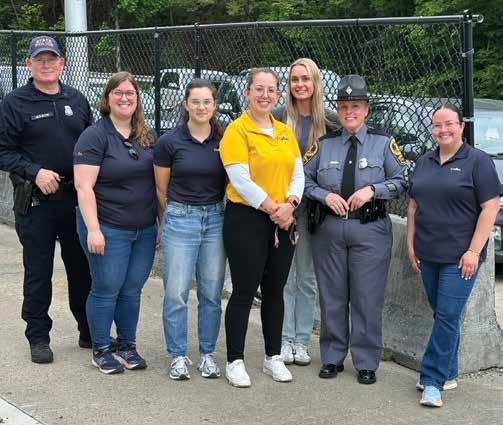
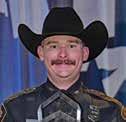
By Ofc. Jared Koester, Commercial Vehicle Enforcement Unit, Fort Worth (Texas) Police Department; North American Inspectors Championship Jimmy K. Ammons Grand Champion
I can’t take full credit for the idea of including a crossword puzzle in this article. Tomasz Krolak, 2023 North American Inspectors Championship (NAIC) Jimmy K. Ammons Grand Champion, created a fantastic one in his final article last year. Inspired by that, I wanted to try something a little different as well. I hope y’all enjoy it. (And I wonder if future grand champions will continue the trend…)
At the time of writing this, the 2025 NAIC event is about two months away. I’m looking forward to attending this year’s event and watching the best of the best inspectors compete against one another. The dedication, time and effort it takes to reach that level is truly remarkable, and I wish all the competitors the very best of luck.
It’s been a real pleasure contributing to “Guardian” this past year. I’ve genuinely appreciated all the feedback and support, and I hope you’ve found something useful or meaningful in the articles I’ve shared.
Additionally, thank you to CVSA WriterEditor Emily Moorhead, editor of the magazine, who has been extremely helpful in putting these articles together and for her patience each quarter, as I may have struggled to have them submitted on time.
There will be a new Jimmy K. Ammons Grand Champion by the time you read this, so I’d like to end by saying CONGRATULATIONS to the new reigning champ of the 2025 North American Inspectors Championship. You earned it!
Stay safe, and God bless. n
Across:
4. A _____ _____ should not be marked on the outer package of a Division 6.2 material.
7. The _____ sign fixes the proper shipping name.
9. UN1009.
10. Of what material is the inner receptable of an IBC with the packaging code “31HA1” made?
12. 1 Ci = .037 _____.
13. This is the relative rate of evaporation of materials to assume the vapor state.
14. This word may be used interchangeably with the word “toxic” in the U.S.
15. One _____ equals 100kPa.
17. A material with a vapor pressure > 300kPa.
18. Name of the label for Division 5.1.
Down:
1.The packing group must be shown in _____ _____.
2. Additional _____ _____ are indicative of subsidiary hazards.
3. UN portable tanks must be fitted with _____ or inspection openings suitable for internal inspections.
5. A bulk package containing regulated medical waste must be marked with a _____ marking.
6. Unless specifically authorized, the shipping description may not contain any _____.
8. UN1086 vinyl chloride must be stabilized to prevent dangerous _____ prior to being transported.
11. Orientation arrows are not required on _____ packages.
16. This acronym means a quantity in a single package exceeding 1000TBq.

By Adrienne Gildea, CAE, Deputy Executive Director, Commercial Vehicle Safety Alliance
With the U.S. Congress in recess and the transportation committees likely months away from proposing language for the next surface transportation reauthorization, there is not much to report in this edition of the Legislative and Regulatory Rundown. My last column focused on one of the Alliance’s latest legislative recommendations, calling for the establishment of minimum qualification standards for entry as a motor carrier. (If you haven’t read it, I highly recommend it.) Keeping with that trend, in this edition of “Guardian,” I want to highlight another new policy recommendation CVSA is pursuing in the next highway bill and how it will improve commercial motor vehicle (CMV) safety: expanding the applicability of the drug and alcohol testing and reporting requirements in Title 49 Code of Federal Regulations Part 382 to include non-commercial driver’s license (CDL) CMV drivers.
We continue to see alarming numbers clearly demonstrating that impaired driving remains a key factor impacting CMV safety on our roadways. Data from the Federal Motor Carrier Safety Administration (FMCSA) shows that, as of June 2025, 304,432 drivers have been cited in the Drug and Alcohol Clearinghouse for at least one drug/alcohol violation. Of those drivers cited, 114,030 have completed the return-to-duty process and are no longer in a prohibited status. The remaining 190,402 drivers have not completed the return-to-duty process and remain prohibited from operating a CMV. That’s more than 60% of drivers who have been cited for a drug/alcohol violation that remain in prohibited status and have not completed the process of returning to duty to operate a CMV.
This begs the question: Where are these prohibited CDL holders going? The Alliance’s membership is concerned that some of them may be moving to the non-CDL space to skirt around the Drug and Alcohol Clearinghouse requirements and continue operating CMVs, despite their ongoing prohibited status.
Currently, compliance with the drug and alcohol testing and reporting requirements in Part 382 apply only to CDL drivers and exclude drivers operating the 11 million non-CDL CMVs
on U.S. roadways (e.g., light trucks, delivery vans and small buses). Meanwhile, recent data from FMCSA shows an increase in crashes and fatalities in the non-CDL CMV sector. For example, from 2021 to 2022, the number of CMVs involved in a fatal crash with a weight rating between 10,001 and 14,000 pounds increased 4%. In fact, FMCSA has observed increases in fatal crashes involving large trucks with a weight rating between 10,001 and 14,000 pounds every year since 2016.
There is not a clear line connecting the increase in non-CDL crashes with these prohibited drivers. However, we have seen instances in which a motor carrier is hiring for a non-CDL CMV driver position and because the motor carrier is not required to check the driver’s status in the Drug and Alcohol Clearinghouse, they may unknowingly bring on a driver in a prohibited status, placing an unsafe driver back on the roadway. If that driver is stopped for an inspection and found to be prohibited from driving a CMV, the motor carrier is then penalized for employing a driver in a prohibited status.
CVSA’s members agree that if being in a prohibited status within the Drug and Alcohol Clearinghouse disqualifies a driver from operating any CMV, then all CMV drivers should be subject to the drug and alcohol testing and reporting requirements found in the safety regulations, regardless of whether or not they are required to possess a CDL. To address this oversight in the safety regulations and close this loophole that allows disqualified drivers to continue to operate in commerce, CVSA is currently advocating for expanding the applicability of the drug and alcohol testing and reporting requirements in Part 382 to include non-CDL CMV drivers.Our goal is to ensure that no driver who has been disqualified for a drug/alcohol violation is permitted to get behind the wheel of any CMV without completing the return-to-duty process required.
For a full list of CVSA’s reauthorization priorities, visit www.cvsa.org/policy/ reauthorization. n
Congress adjourned for its August recess with much left to do before the fiscal year ends. Both the House and Senate have developed appropriations bills funding the federal government for fiscal 2026. However, the two proposals have to be reconciled and the climate on the Hill, along with the narrow leadership margins, make passing a final bill a challenge.
In addition, the Senate continues to consider and approve the president’s political appointees. Most notably, nominees for both FMCSA and the Pipeline and Hazardous Materials Safety Administration await a full vote of the Senate when the chamber reconvenes. Neither candidate is considered controversial, and both are expected to be approved – their biggest hurdle will be finding time in the busy Senate calendar for consideration. CVSA, along with other industry organizations, expressed its strong support for FMCSA nominee Derek Barrs and we are hopeful the Senate moves quickly to confirm him once the body reconvenes in September.
Meanwhile, the House and Senate transportation committees are busy at work drafting the next surface transportation bill. The committees have held a series of hearings, solicited stakeholder input and requested member priorities. CVSA staff have been meeting with committee and member office staff in the House and Senate to advance the Alliance’s policy positions. Committee chairs in both chambers have expressed a desire to pass the next highway bill before the end of this Congress in 2026.

By Katerra Sweat, Program Management Operations Specialist, Nonproliferation Program Office, Oak Ridge National Laboratory
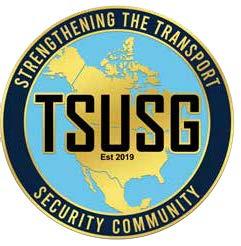
The Transport Security Unified Stakeholders Group (TSUSG) provides a forum for members to collaboratively identify transport security challenges and develop solutions that strengthen radioactive source transport security for the nation. TSUSG has been operational since 2019 under the guidance of Oak Ridge National Laboratory (ORNL).
Consisting of voluntary members and functional groups from federal and state governmental agencies and state law enforcement groups, TSUSG comprises industry (source and source equipment producer, shipper, motor carrier and forwarder) members, as well as participants from related professional associations. The TSUSG operating approach identifies and prioritizes transport security issues, facilitates a common understanding, and develops, implements and monitors solutions to these issues. TSUSG integrates its efforts with best practices and existing safety-focused regulations, practices and procedures to ensure transportation processes for radioactive sources are secure and to keep the public and the environment safe.
Through 2024, TSUSG membership grew significantly across all functional groups, with strong expressions of interest continuing to emerge. Efforts have been made to develop and implement activities that guarantee members remain engaged throughout the year. Key issues are addressed by broad, cross-functional groups, known as priority committees (PCs), which are tasked with reviewing, investigating, researching and developing best practices related to mitigating or resolving these issues. Each PC is led by a PC coordinator and supported by a dedicated team of ORNL TSUSG staff members.
Meetings are conducted monthly or more frequently as activities demand. TSUSG will continue to establish a robust repository of best practices that will be invaluable to the TSUSG functional groups and will contribute to the overarching goal of enhancing the security of radioactive source transport within the U.S. Members of TSUSG can access the previous outcomes of PCs through the members’ website. Currently, four active PCs are underway:
PC8: Training – Maps training needs and requirements, including exploring various delivery opportunities, such as tabletop exercises, workshops and other training formats.
PC9: Cybersecurity – Reviews current cybersecurity issues alongside GPS spoofing/jamming approaches and vulnerabilities. This PC aims to develop recommendations for consideration by TSUSG.
PC10: Artificial Intelligence – Investigates the implications of the rapidly evolving AI landscape and its impact on transportation security.
PC11: Interstate Escorting – Studies stateby-state escorting practices to develop a national standard operating procedure best practice guideline.
An additional PC, PC12: State-by-State Inconsistencies, has been voted on by members and is in the process of launching. This fifth committee will review the inconsistencies in processes and requirements from state to state. Like all open PCs, it always accepts volunteers.
TSUSG formally added Category 3 materials to its operational scope as part of its ongoing commitment to enhancing security protocols for the transport of these materials.
The annual TSUSG meeting will be held Sept. 9-11 in Denver, Colorado. In anticipation of the annual meeting, quarterly tactical meetings will continue to feature and support the cross-functional scope, activities and working relationships of the various functional groups.
Quarterly tactical meetings for fiscal year (FY) 2025 (Oct. 1, 2024, through Sept. 30, 2025) included the following virtual events:
FY 2025 Q1: Drone Threats and Uses Related to Transport, with Jairus Hines
FY 2025 Q2: Insider Threat Prevention through Vetting and Behavior Observation, with John Landers
FY 2025 Q3: Supply Chain Analysis, with Scott Brooks
TSUSG outreach efforts include presence at and participation in meetings of the following organizations, among others:
Commercial Vehicle Safety Alliance
Cooperative Hazardous Materials Enforcement Development
National Transportation Stakeholders Forum
Institute of Nuclear Materials Management Conference of Radiation Control Program Directors
Packaging and Transport of Radioactive Materials
Interest in TSUSG activities continues to grow, and the TSUSG mandate is increasingly recognized as a valuable addition to the programs and practices of many diverse organizations and associations, including CVSA.
TSUSG would like to extend a heartfelt thanks to CVSA Level VI Inspection Specialist Carlisle Smith, who has consistently been a champion for the group. CVSA actively participates in TSUSG activities, including PC membership events and meetings. TSUSG values this relationship with CVSA and encourages even greater engagement from its members in its initiatives and activities moving forward. Your contributions are vital to the TSUSG mission and help strengthen the foundation of the organization. Thank you for your continued support.
The TSUSG website, accessed at www.tsusg. ornl.gov, is being updated and upgraded, and these ongoing enhancements will significantly improve processes and communication. n
As always, CVSA members are invited to join TSUSG. Please contact the undersigned if you have any questions or if you would like to discuss the group further.
Questions: TSUSG@ornl.gov
Shannon Morgan: morganss@ornl.gov
Katerra Sweat: sweatkl@ornl.gov
By FMCSA Office of Research; Crash Causal Factors Program Team; Jenny Guarino, Crash Data Analytics Division Chief; Dan Meyer, Transportation Specialist; Kelly Stowe, General Engineer; and Emma Steinberger, Management and Program Analyst
The Federal Motor Carrier Safety Administration (FMCSA) is preparing a new study that will provide up-to-date, detailed insight into the factors that contribute to crashes involving large trucks.
The Heavy-Duty Truck Study is part of the agency’s new Crash Causal Factors Program (CCFP), which establishes a collaborative approach to collecting, sharing and analyzing crash data.
The last few years have seen a concerning rise in fatal crashes involving commercial motor vehicles (CMV) in the United States. From 2016 to 2022, fatal crashes involving large trucks increased 26.4%. To help reverse this trend, the U.S. Congress allocated funds for FMCSA to study the factors that contribute to crashes involving large trucks.
The Heavy-Duty Truck Study builds upon the Large Truck Crash Causation Study (LTCCS) by continuing this critical analysis with a refined scope and a larger sample size. Although the LTCCS was published nearly 20 years ago using data from 2001-2003, state agencies, safety advocacy groups, motor carriers and others
continue to rely upon the study to guide internal policies and decisions.
Since 2003, changes in the transportation industry have underscored the need for an updated study. For example, the number of regulated carriers has increased 20% between 2004 and 2022, and the number of registered large trucks has increased 81% between 2003 and 2022.
The current study aims to update and advance our understanding of crashes, creating resources that public and private entities can use to improve safety.
The Heavy-Duty Truck Study focuses specifically on fatal crashes involving Class 7 and 8 heavy-duty trucks, addressing the largest segment of fatal crashes involving large trucks. Class 7 and 8 trucks account for more than 70% of large trucks involved in fatal crashes reported to FMCSA.
Beginning in 2026, the study will collect data on a target sample of 2,000 fatal crashes involving heavy-duty trucks from about 30 states over a two-year period.
Data collection for the study is a collaborative effort that relies on partnerships with state agencies and the Bureau of Transportation Statistics (BTS), as well as the cooperation of motor carriers, drivers, passenger vehicle occupants and other parties involved in a crash.
Data for the Heavy-Duty Truck Study will come from two main streams: state-collected crash data and confidential interview data collected by BTS.
The first data stream comes from data collected as a part of states’ standard crash response, including police crash reports, postcrash investigations or reconstructions, and post-crash inspections. State collaboration allows for the use of existing crash data for analysis efforts, streamlining collection and maintaining quality data.
FMCSA identified a nationally representative sample of states by evaluating historical crash data and the information the states provided about their crash response procedures, policies and resources. However, data

collection is not restricted to the 30 sample states, and FMCSA encourages all states to contribute their crash data to the CCFP database.
The second stream of data collection comes from confidential interviews conducted by BTS, which is part of the U.S. Department of Transportation and one of 13 principal statistical agencies in the federal government. For the Heavy-Duty Truck Study, BTS will interview CMV drivers, motor carrier representatives, passenger vehicle drivers and occupants, witnesses, pedestrians and others involved in the crash. This will provide a more comprehensive understanding of crashes while maintaining confidentiality for the interviewees.
Confidential interviews may address topics including but not limited to scheduling, vehicle inspection and maintenance, driver hiring practices, driver compensation and benefits, distracted driving, and truck stop/rest area availability. The interviews will be conducted on qualifying crashes that occur in one of the 30 sample states, regardless of where the carrier involved in the crash is domiciled.
In other words, carriers domiciled outside of the sample states will be contacted for interviews if they have been involved in a qualifying crash while driving through these states.
BTS has extensive experience collecting and protecting confidential information for statistical purposes. The agency’s confidentiality statute and the Confidential Information Protection and Statistical Efficiency Act (CIPSEA) protect the information BTS collects.
When collecting data under CIPSEA protection, BTS must pledge confidentiality to the interview respondent, use data for statistical purposes only and protect data from unauthorized use and release. “Statistical purpose” means that data must be aggregated in such a way that no individual respondent or the information that they provided can be identified. Furthermore, personally identifiable information cannot be used for regulation or enforcement. BTS is prohibited from releasing data to other government agencies, the courts (i.e., data collected cannot be admitted as evidence) or Freedom of Information Act requests.


• FMCSA collects information from State and local jurisdictions about current post-crash data collection procedures.
• In-scope States are identified for a nationally representative sample. FMCSA develops the analysis plan. Study Design
• FMCSA works with States to complete data sharing agreements/memoranda of understanding (MOUs).
• FMCSA creates a CCFP database, implements data protection measures, and develops tools and training to support data collection.
If BTS violates these confidentiality promises, BTS employees and contractors are subject to removal from office and Class E felony conviction with fines up to $250,000 and/or five years’ imprisonment.
Research yielding more information on crashes involving heavy-duty trucks can produce a more comprehensive understanding of crash causal factors that will improve roadway safety nationwide.
To receive updates about the CCFP and the Heavy-Duty Truck Study, please subscribe to the CCFP mailing list at www.fmcsa.dot.gov/CCFP. FMCSA plans to host webinars this fall to provide detailed information on the study. Webinar dates and registration information will be posted on the website and sent to the mailing list.
For any questions, please contact CCFP@dot.gov. n



• Leveraging the work of State and local partners, FMCSA begins collecting data.
• After two years of data collection, FMCSA begins analysis.
• FMCSA releases a database of anonymized crash data for public use.
• FMCSA releases the Heavy-Duty Truck Study final report.
Note: Partial data findings and analysis will be released prior to the final report.

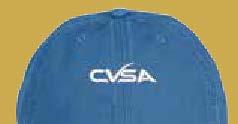






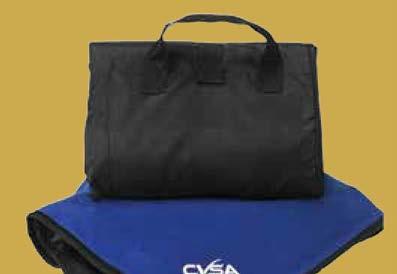



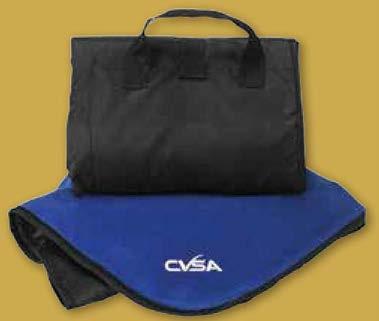
Select your item, customize the size/fit and color, and have it shipped directly to your house.
Goods and Accessories
l Bags
l Hats
l Flashlights
l Blankets





l Drinkware
l And More
Apparel
l T-Shirts
l Pullovers
l Jackets
l Dress Shirts
l Hoodies and Sweatshirts
l Vests and Outerwear
Available in a variety of colors in men’s and women’s cuts and sizes.

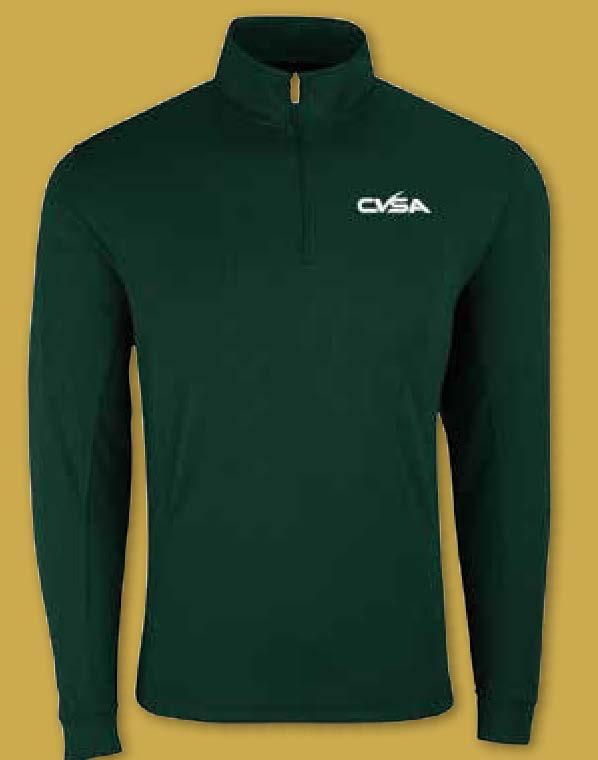



















By Gragg Wilson, Professional Truck Driver, UPS; America’s Road Team Captain
With state truck driving championship (TDC) season in full swing, it’s the perfect time to reflect on why we do what we do – and how we prepare to compete at the highest level of our profession.
My name is Gragg Wilson. I’ve been a professional truck driver for nearly 40 years, proudly representing UPS of Sparks, Nevada. Over the course of my career, I’ve logged more than 3 million safe driving miles. I’m also honored to serve as an America’s Road Team Captain, and this year, I’ll be competing in my 15th National Truck Driving Championship (NTDC) in Minneapolis, Minnesota.
TDC and NTDC aren’t just competitions – they’re celebrations of safety, skill and professionalism. For me, these events have been instrumental in shaping who I am as a driver and a person. They’ve sharpened my focus, deepened my commitment to safety and reinforced industry-defining values.
To qualify, drivers must have at least one year of safe driving. That requirement alone speaks volumes about the level of discipline and awareness expected of competitors. For me, it starts with a good night's sleep – the foundation of a safe day on the road. From there, I check weather conditions, road closures and construction updates before heading out. A thorough pre-trip inspection is next – both in daily operations and in competition. At TDC, we go above and beyond, scrutinizing every detail of our vehicle to ensure it’s in top condition.
While we do train specifically for the skills portion of the competition, the truth is, we’re always practicing. Every mile is an opportunity to refine our abilities. It’s hard to explain exactly how competition makes you a better driver, but it does. You become more efficient, more precise and, above all, more safety-minded.
That mindset carries over into everyday decisions. For example, if I’m asked to park in a tight spot, I’ll choose a wider, safer space, even if it takes a little longer. Why risk an incident when there’s a better option? That kind of thinking is second nature to TDC competitors.
Another key component of the competition is the written test, based on the “Facts for Drivers” manual. Preparing for it means immersing ourselves in topics like first aid, fire safety, trucking regulations and industry history. It’s not just about passing a test – it’s about becoming a more informed, wellrounded professional.
What makes TDC and NTDC truly special, though, is the community and the camaraderie. Over the years, I’ve built lasting friendships with drivers from across the country and from all kinds of companies.
We call each other our “TDC family,” and that bond is one of the greatest rewards of competing.
None of this would be possible without the unwavering support of the trucking industry, our employers, state trucking associations, the American Trucking Associations, our friends and – most importantly – our families. Their encouragement fuels our drive to be the best we can be.
At the end of the day, my goal is simple: to get home safely and help ensure everyone else on the road does too. That’s the heart of what we do. And that’s why we compete. n

By Kim Claytor, Compliance Director/Sales Manager, FleetSafe Solutions
In the drug testing industry, a consortium/ third-party administrator (C/TPA) is a company that provides DOT-regulated and non-DOT-regulated testing programs. The U.S. Department of Transportation (DOT) added C/TPAs when they revised the U.S. DOT drug and alcohol testing regulations, which can be found in Title 49 Code of Federal Regulations Part 40.
The Federal Motor Carrier Safety Administration (FMCSA) website defines a C/TPA like this: “C/TPAs manage all, or part, of an employer’s U.S. DOT drug and alcohol testing program, sometimes including maintaining required testing records. They perform tasks as agreed to by the employer to assist in implementing the drug and alcohol testing program and to help keep the employer compliant with the U.S. DOT/ FMCSA drug and alcohol testing rules and regulations.”
This indicates that FMCSA allows the employer to seek assistance in understanding and complying with the regulations outlined in Parts 40 and 382.
A professional, knowledgeable C/TPA can be a powerful partner for the transportation employer. But what about those C/TPAs that fall short? Let’s explore what the employer and enforcement officials should be aware of when it comes to choosing a C/TPA.
While many C/TPAs manage the required testing and random selections of multiple employers, a true C/TPA should also provide, at a minimum, U.S. DOT policies, driver educational materials, reasonable suspicion supervisory training, FMCSA Clearinghouse services, substance abuse professional (SAP) referrals and more. In addition, the C/TPA is allowed to group smaller companies together in a larger grouping for random selections. This is called a “consortium.”
A compliant C/TPA will monitor the consortium, ensuring all selections are completed and U.S. DOT random ratios are met. If a participating company does not test as directed, the C/TPA should either generate another selection or remove the employer from the consortium and set them up independently. Companies with large numbers of drivers are managed as independent random selection groupings per company.

Owner-operators are required by regulation to be enrolled in a C/TPA consortium for random drug and alcohol testing. Further, if owneroperators do not complete their testing, the C/TPA may enter this failure to test as a “refusal to test” in the Clearinghouse. In essence, for owner-operators, the C/TPA is required to be their designated employer representative, also managing any SAP-related return-to-duty and follow-up plans.
When considering a C/TPA, there are important factors to consider. The employer will want to ask the following questions: How long has the C/TPA been in operation? Can they provide client references?
Does the C/TPA offer a full-service program in addition to U.S. DOT testing and random selections – policies, training, management information system reports, audit support, FMCSA Clearinghouse services, postaccident assistance, SAP referrals and follow-up plan management?
Does the C/TPA have the expertise and knowledge needed for all Part 40/Part 382 regulations? This can be determined by asking simple questions regarding the experience and expertise of the C/TPA staff.
Industry associations, such as the National Drug and Alcohol Screening Association, offer voluntary credentialing of C/TPAs through a process that verifies their expertise. While not required, this type of credentialing offers the employer assurance of a knowledgeable partner.
Section 40.11 stipulates that although a C/TPA may be hired to manage the employer’s U.S. DOT testing program, it is the responsibility of the employer to ensure compliance. This is why vetting C/TPAs is so important. § 40.11 says:
(a) As an employer, you are responsible for meeting all applicable requirements and procedures of this part.
(b) You are responsible for all actions of your officials, representatives and agents (including service agents) in carrying out the requirements of the U.S. DOT agency regulations.
(c) All agreements and arrangements, written or unwritten, between and among employers and service agents concerning the implementation of U.S. DOT drug and alcohol testing requirements are deemed, as a matter of law, to require compliance with all applicable provisions of this part
and U.S. DOT agency drug and alcohol testing regulations. Compliance with these provisions is a material term of all such agreements and arrangements.
C/TPAs are considered service agents. Thus, the employer should have written contracts and agreements that clearly state what the C/TPA will provide and be responsible to the employer for. If a provider will not issue a written contract or agreement, the best practice would be to decline the services. The employer depends on their C/TPA to ensure compliance with U.S. DOT regulations and to provide professional, knowledgeable and compliant service
Because § 40.11 ultimately places the responsibility for compliance back on the employer, choosing a C/TPA with knowledgeable staff and experience is vital. The employer will be cited and penalized for what a C/TPA does that is in violation of Part 40 and Part 382.
While Part 383 outlines public interest exclusion proceedings should a service agent be in violation of Part 40 requirements, this type of enforcement action against a C/TPA is rare. The transportation community should ask why this is so rare. The answer is most likely due to time restrictions during compliance reviews or safety audits. If, on the surface, things look good for a specific company, enforcement officials are not likely to look deeper.
Due to the increased number of acquisitions and abrupt closures in the C/TPA industry, employers are often left with missing records required by FMCSA. Part 349 clearly states that even if a C/TPA goes out of business, it still has a responsibility to produce the records it has for the employer. However, this often does not happen, leaving the employer at risk and out of compliance.
In addition, many entities purport to be C/ TPAs when, in fact, they are not. One example is an entity that only provides random selections and testing services. It does not provide the required training, policies, regulatory updates, FMCSA Clearinghouse
services and support that make a C/TPA. The purpose of U.S. DOT drug and alcohol testing programs and the FMCSA Clearinghouse is to ensure commercial drivers are substance-free behind the wheel. However, the support and expertise needed by a full-service, compliant C/TPA can be lacking.
Perhaps now is a good time for mandatory C/TPA credentialing. This would provide the enforcement community with clear guidelines to follow as part of the compliance review or safety audit process.
If a C/TPA fails in its responsibility to the employer, it could be held to equal account as the employer. The continued operation of a substandard C/TPA or the lack of consequences for its company officials puts our transportation community and those traveling on our highways at risk.
Since 2001, many entities representing themselves as C/TPAs have appeared, with many providing compliant and knowledgeable services to the transportation industry. Yet, in this less-than-perfect world, there are those C/TPAs lacking in expertise and knowledge of Parts 40 and 382. Most often, the employer does not realize the problems with their C/TPA until it is too late.
The regulations require credentialing and certification for:
• U.S. DOT drug screen collectors
• U.S. DOT breath alcohol technicians
• U.S. DOT substance abuse professionals
• Medical review officers
• Supervisors – reasonable suspicion supervisory training
C/TPA credentialing would be an important piece of the regulatory puzzle to ensure training and expertise of those companies hired to manage U.S. DOT drug and alcohol testing programs for motor carriers.
Let’s think about how we can close the gaps on C/TPA deficiencies. This is an important step to keep highways safer and motor carriers compliant. n
Let’s think about how we can close the gaps on C/TPA deficiencies. This is an important step to keep highways safer and motor carriers compliant.
By Dave Elniski, Ph.D. Student, CTSP, CRSP, ATCL, Industry Advisor, Safety and Compliance, Alberta Motor
Association
One of the things I dislike the most about using rental cars is that they don’t include all of the various emergency supplies I have in my own personal vehicles. I can understand the rental agency’s perspective: If they were to accommodate me in this regard, the smallest vehicle they’d have to offer would be a threerow SUV. I’ll also concede that I’ve never needed traction mats, tire chains, shovels and tools when using a rental, so they’ve got me on the past experience front too.
I probably am biased toward overkill when it comes to outfitting my vehicles and home with the supplies needed for various emergency and inconvenient situations. While I do politely accept the little bit of ribbing I catch from people on this topic, I’ll defend to the end the general principle of being prepared – and not just because it was instilled in me as a value from my time in scouting and the military.
Trucking, parenting and pretty much everything else I’ve done have occasionally put me into emergency situations – or at least unplanned and inconvenient ones. Having basic emergency supplies on hand has, time and time again, been tremendously useful to me. For example, as a trucker, I always had a first aid kit, cell phone headset (charged, along with the phone), basic hi-visibility personal protective equipment and clothing appropriate for the weather. The army took care of this for me with standard kit lists for things to be included in all vehicles and on my person. It just makes sense for me to carry this same logic into my personal life.
It is still important for me to be reasonable, though. Taken to an extreme, I would eventually just need to drive an ambulance to have all the necessary first aid supplies on hand for various situations. Admittedly, I’ve had to adjust my thoughts around being reasonably prepared.
So, how does one know where the line is for deciding what to carry for various emergencies? This ultimately comes down to the situations one might encounter, what we can do about them and the degree to which we’re willing to offer assistance to others rather than rely on first responders. Also, this doesn’t just apply to vehicles: Being prepared can be applied to all aspects of our lives, like having a backup internet connection when taking important video conferencing calls.
What I want to address, though, is a common response I hear from people when discussing

contingency planning: That’s never happened to me before. Yes, it’s appropriate to consider our own past experiences when contingency planning. However, just like how a company managing risk demonstrates due diligence by taking action to reduce potential losses from things that are foreseeable, only relying on our past experiences isn’t a good approach to being prepared.
Imagine if we could only learn from our own mistakes. Everyone would have to experience serious injuries to see the importance of first aid training. The only people advocating for fire exits and fire drills would be those who personally survived a building fire. We’d all have to put a vehicle in the ditch before truly seeing the value in driving according to road conditions. It's not a great system.
Fortunately, we’re capable not only of learning from the mistakes of other people but also of anticipating potential emergency/unplanned events and taking appropriate action to experience better outcomes. Unfortunately – and frustratingly – many folks still only become passionate advocates for safety after personally experiencing bad things.
This is why it’s essential to challenge the idea that just because we haven’t experienced some form of loss ourselves, it doesn’t mean the event in question is less likely to happen. If there’s a 10% chance something will happen, it’s still 10% whether we’ve experienced the thing in question or not. But if we’ve personally had the experience in question, it will likely feel more probable than 10%. This is normal, but it’s something that we need to challenge, especially in safety management
and especially when we have information to help us make better decisions.
Why does this matter? In my opinion, it matters for one specific and exciting reason: We have the power to prevent bad things from happening – bad things that have never happened to anyone before. Sure, it might be harder due to a lack of past experience from which to draw, but as long as we can somewhat foresee a bad thing and have a degree of control over it, we can take action to prevent it from happening.
This is truly the ultimate purpose of proactive safety management – not waiting for bad things to happen but, instead, working to make sure they never happen in the first place. As technology advances alongside our understanding of organizational behavior and risk management, we’ve never been in a position with more tools to help us proactively improve safety performance. Furthermore, this is a concept that individuals can practice in their own lives just as much as organizations can – and in more applications than workplace safety management.
Finally, there’s another side to us being in a time with more tools than ever before to address safety concerns: We’re running out of excuses for not taking action. We can be more forgiving for failure when we can also say something like, “Well, they didn’t know any better,” but it’s a lot harder when the narrative is more like, “Well, that’s what we’ve been saying would happen for years, yet they took no action to prevent it.” n
By Mark Samber, Independent Industry Advisor
In professional football, the playbook is an indispensable guide, outlining every offensive and defensive strategy a team needs to execute for success on the field. Each player must understand their role, anticipate challenges and adapt to real-time changes.
Likewise, fleet safety programs serve as a crucial blueprint for drivers and operators, ensuring that every team member knows how to prevent accidents, respond to emergencies and maintain a culture of safety.
While NFL teams chase victory, fleet safety programs aim to protect lives, reduce liabilities and enhance operational efficiency. Yet the underlying principles remain the same – both require clear communication, adherence to procedures, ongoing training, adaptability and a relentless commitment to excellence. By equating fleet safety to NFL playbooks, organizations can drive their safety initiatives toward greater success.
NFL teams rely on playbooks to guide their approach to every game, detailing formations, tactics and contingency plans. In fleet operations, a safety program serves a similar role, outlining policies and procedures for vehicle handling, accident prevention and emergency response. Both playbooks and safety programs are meticulously designed, considering all possible scenarios and ensuring readiness in high-risk situations.
In football, the coaching staff collaborates to develop and refine plays, tailoring them to the strengths and weaknesses of the team. Fleet safety programs require a similar approach – drivers, fleet managers and safety experts must work together to create comprehensive guidelines that address vehicle maintenance, driver behavior and risk mitigation. Just as NFL teams adjust their playbooks to evolving game conditions, fleet safety programs must continuously adapt to regulatory changes, new vehicle technology and emerging road hazards.
A playbook is ineffective if players fail to execute plays correctly. That is why NFL teams dedicate hours to practice, study film and drill strategy. Likewise, fleet safety training is essential for ensuring drivers understand policies and procedures, translating written

protocols into safe and efficient driving behaviors.
Football teams host training camps, drills and meetings to reinforce knowledge. Fleet operators must implement regular safety training sessions, defensive driving workshops and hands-on simulations to prepare drivers for real-world challenges. Knowing how to navigate hazardous weather, avoid distracted driving and respond to emergencies are all critical skills that must be ingrained through continuous training.
Veteran NFL players mentor rookies, ensuring they understand the intricacies of play execution. Similarly, experienced fleet drivers can guide new recruits, offering insights into best practices and reinforcing a safetyfirst culture. Just as football teams depend on leadership to drive success, fleet safety programs benefit from seasoned professionals who set an example for responsible driving.
NFL playbooks evolve throughout the season, with coaches analyzing opponents and modifying plays based on new data. Fleet safety programs must adopt the same mindset, adjusting protocols based on accident reports, changing traffic patterns and advancements in vehicle safety technology.
Consider the impact of innovation in both fields. Football teams use analytics to refine plays and improve decision-making. Fleet operators leverage telematics, GPS tracking and AI-driven monitoring systems to enhance safety and efficiency. Embracing new technology allows organizations to refine
their safety strategies, reducing incidents and optimizing driver performance.
Additionally, halftime adjustments in football allow teams to correct mistakes and seize new opportunities. Fleet safety programs must conduct ongoing audits, review accident trends and gather driver feedback to ensure continuous improvement. Data-driven insights help organizations refine protocols and proactively address risks.
Clear communication is vital in football, where quarterbacks relay play calls and players coordinate movements to execute strategies effectively. Fleet operations require equally effective communication – drivers must report hazards, managers must disseminate safety guidelines and teams must synchronize efforts to mitigate risk.
Consider an NFL quarterback calling an audible after recognizing a defensive shift. In fleet safety, this equates to a driver recognizing an unexpected road hazard and adjusting their actions accordingly. A well-structured safety program encourages proactive decision-making, empowering drivers to adapt and respond in real-time to maintain safe operations.
NFL teams conduct pre-game meetings and in-game huddles to refine their approach. Fleet safety programs benefit from daily briefings, safety bulletins and routine inspections to reinforce best practices. Open communication ensures that safety expectations remain clear and drivers stay informed about new developments.
Continued on next page
Continued from page 63
NFL teams monitor performance metrics –completion percentages, turnovers and yard gains – to assess effectiveness and refine strategies. Fleet safety programs similarly rely on metrics such as accident rates, fuel efficiency and driver behavior tracking to measure success and identify areas for improvement.
Just as football players are accountable for executing plays correctly, fleet drivers must take responsibility for following safety protocols. Frequent infractions or negligence in driving can lead to accidents, financial consequences and reputational damage. Both fields emphasize accountability, reinforcing that every individual plays a crucial role in achieving overall success.
A championship-winning football team thrives on leadership, teamwork and trust. The same principles apply to fleet safety programs, where managers, drivers and support staff must work collaboratively to uphold high safety standards.
NFL coaches inspire players to commit to discipline and execution. Fleet managers must instill the same mindset, fostering a culture where safety is prioritized above all else. When drivers understand the value of safe practices, they become proactive in preventing accidents, protecting lives and ensuring long-term fleet success.
Whether on the football field or behind the wheel of a fleet vehicle, preparation, training, adaptability, communication and leadership dictatesuccess. An NFL playbook provides structure and guidance to players – just as a fleet safety program ensures drivers operate responsibly and mitigate risks.
By embracing the strategic approach of an NFL playbook, fleet safety programs can enhance driver awareness, improve risk prevention and create a culture where safety is the ultimate game plan. In both football and fleet operations, victory comes not only from executing plays correctly but from ensuring every team member works together toward a common goal: staying safe and making smart decisions that protect the lives of everyone on the road. n
By Mike Millard, President/Chief Safety Officer, AWM Associates
From 1976 to 1985, I drove a truck in the U.S. Army. I turned wrenches, made simple repairs, hauled communications gear and supervised a host of young men and women who refueled aircraft. From 1976 to 1982, I hauled 5,000gallon tankers used for JP-4 (jet fuel). From 1978 to 1980, I developed my backing skills in Germany with 45-foot trailers.
In 1980, I fractured my right tibia and fibula playing softball in Germany. The fracture was bad and required a steel plate. I was placed on a medevac flight to the U.S. as the Cold War was hot and heavy. In 1981, I told my re-enlistment noncommissioned officer I needed any advanced individual training in electronics for six months or longer. I ended up at Ft. Gordon, Georgia, for mainframe communications terminals. Fast forward to September 1985 – I departed the military to be an expatriate. I worked abroad until June 1991, when Mount Pinatubo erupted in the Philippines. Mainframes were dying, and desktop computers were growing in popularity. My last job in electronics was working on bank automatic teller machines for about one-third of what I made as a mainframe tech.
In 1992, I acquired my commercial driver's license and drove over-the-road (OTR), regional and local routes until 1996. My wife and I had our second son in 1996, so with a growing family, I went back to school, thanks to the Veterans Administration. I went to school full time from 7 a.m. until 3 p.m. and worked from 4 p.m. until midnight. I struggled with homework from midnight to 7 a.m. Some days, I survived on two or three hours of sleep.
In 1997, Colorado offered me a position as a Port of Entry (POE) officer intern at the scale in Cortez, Colorado. At that time, the POE was under the Colorado Department of Revenue. In November 1998, I attended the CVSA North American Standard Truck Inspection Course in Denver to be a safety inspector and conduct Level I and Level III Inspections. Dave LaPort asked inspectors to complete 10 Level I Inspections a day on inspection days, so my inspection days were usually more than eight hours.
In 1999, I applied to the Office of Motor Carrier Safety (OMCS) asking for Arizona, Wyoming, Idaho or Washington. I went to work for OMCS in Illinois in October 1999. I was familiar with ASPEN, so I offered to teach it at the Midwest Service Center’s inservice training in Minnesota in March 2000.
I taught ASPEN again at the Federal Motor Carrier Safety Administration’s (FMCSA) IT Conference in Louisville, Kentucky, in 2004. Joseph Clapp, the first Congressionally approved FMCSA administrator, thought it’d be a good idea for FMCSA special agents (SAs) to know what a truck looked like. Mr. Clapp initiated the program requiring SAs to inspect commercial motor vehicles.
I left FMCSA in June 2010 to work for the U.S. Department of Energy in New Mexico as a transportation management specialist. I needed a day job where I was close to home, so it was a necessary move. In 2011, I started AWM Associates LLC and retired from the federal government in May 2020 with 30 years of federal service.
I have a TikTok channel where I try to dispel myths and educate carriers/drivers on the Hazardous Materials Regulations and Federal Motor Carrier Safety Regulations (FMCSR). I’m not the most popular, as I take a hard line on safety, and the viewers often want to shoot the messenger.
I take mental notes and am curious: Do Motor Carrier Safety Assistance Program officers think about the 60-hour clock? Over 50% of the 813,000 carriers with a U.S. DOT number have one vehicle. For a driver to operate seven days a week and not max out the 70-hour clock, they can work a max of 8.75 hours a day. As an OTR driver from 1992 to 1996 –when there was no 34-hour reset – I am aware of the recapping of hours of service to avoid 70-hour rule violations.
See § 395.3 below.
§ 395.3 Maximum driving time for property-carrying vehicles.
(b) No motor carrier shall permit or require a driver of a property-carrying commercial motor vehicle to drive, nor shall any driver drive a property-carrying commercial motor vehicle, regardless of the number of motor carriers using the driver's services, for any period after:
(1) Having been on duty 60 hours in any period of seven consecutive days if the employing motor carrier does not operate commercial motor vehicles every day of the week; or
(2) Having been on duty 70 hours in any period of eight consecutive days if the employing motor carrier operates commercial motor vehicles every day of the week.
As a POE officer for Colorado from 1997 to 1999 and motor carrier safety/hazardous materials specialist for OMCS/FMCSA from 1999 to 2010, I was by the book. It is an inspector's responsibility to enforce the regulations equally.
I tend to voice my opinion on applications for exemptions applied for via Part 381. As a roadside inspector from 1998 to 2010, I know exemptions can be troublesome. I recently spoke out against an application by a military reserve unit wanting an exemption from the commercial driver’s license requirement, as reservists were not covered by the exception in § 383.3(c) for certain military members. FMCSA approved the exemption; however, there’s a permanent change coming based on the Federal Register published May 30 to include reservists.
Social media has changed how information is shared and the range of viewers seeing an inspection when it is recorded and posted online. For instance, an inspector who misspoke and called a wheel seal leak on an air-operated disc brake a "brake fluid leak" on a video posted by a driver received multiple negative comments. Inspectors should cautiously consider the information they provide when a driver is holding a phone. As Abraham Lincoln said, "It is better to be thought a fool and remain silent than to speak up and remove all doubt."
I see a rising number of drivers refusing to assist the MCSAP officer in conducting a roadside inspection by declining to operate lights, brakes, etc. I have done some basic research and discovered Alabama statute Section 13A-10-3, Refusal to assist, and Connecticut statute Title 51a Chapter 952 Section 53a-167b, Assist officer. § 396.9 only applies to FMCSA SAs. If you know of a similar law/statute in your state, perhaps CVSA could develop a quick reference for MCSAP officers to avoid the uncooperative driver.
Let’s make a long story longer. The management edition of the FMCSR has the “Official FMCSA Guidance,” otherwise known as interpretations, which clarify some issues. FMCSA changed its guidance platform about 12 years ago, and I don't find the updated guidance system to be easy to use. Before this, FMCSA interpretations were similar to the electronic Code of Federal Regulations; they were based on a particular part, and you could view the interpretations based on the part, e.g., Part 395. Now the regulatory
guidance page asks users to search by keywords and issue date. You can sort the guidance by subject, agency identifier, topic and issue date, hopefully to find the content you’re seeking. However, in an example I ran, § 391.15 came before § 391.11, and Part 382 answers on drug and alcohol testing were on tab 133. I have not found the new regulatory guidance to be user-friendly.
Thank you for taking the time to read my article. I believe inspectors have great intentions; however, things happen, and when they do, there are concerns. With today’s social media, sometimes thousands get to see the SNAFU go to FUBAR. n
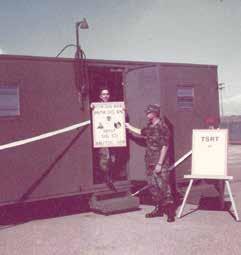

This is an example of one of the trucks I drove during my time in the U.S. Army. The M54A2 5-ton cargo truck was an older model from the Vietnam War era. The cargo cover was removed to make room for two 600-gallon pods, and reel unit with a single cylinder pump unit.

The M813A1 came out around 1980. It differed from the M54A2 in that the cable shut-off for fuel to the fuel pump was for emergency purposes, not daily use. I learned that one the hard way; after pulling out the handle and pushing it back in, the truck wouldn’t start. It took me and a couple of mechanics half an hour to figure out why. The shut off had to be manually reset by hand at the fuel pump.

PRESIDENT
Capt. John Hahn
Colorado State Patrol
VICE PRESIDENT
Maj. Erick McGuire
Florida Highway Patrol
SECRETARY
Sgt. William Alarcon
New Jersey State Police
PAST PRESIDENTS
Col. Russ Christoferson
Montana Department of Transportation
REGION PRESIDENTS
Region I
Tpr. Brian Pfarrer
New Jersey State Police
Region II
F/Sgt. Travis Ingold
North Carolina State Highway Patrol
Region III
Lt. Mike Maytum
Nebraska State Patrol
Region IV
Tpr. Chase Livingston
Arizona Department of Public Safety
Region V
Krista Cull
Newfoundland and Labrador Transportation Regulation Enforcement
ASSOCIATE MEMBER PRESIDENT
Brett Graves, CDS
Maverick Transportation LLC
ASSOCIATE MEMBER VICE
PRESIDENT
Stephen Keppler
Scopelitis Transportation Consulting
LLC
COMMITTEE CHAIRS
Audits and Investigations Committee
Keith Kerns
Public Utilities Commission of Ohio
Crash Data and Investigation
Standards Committee
Lt. Mike Maytum
Nebraska State Patrol
Driver-Traffic Enforcement Committee
Capt. Chris Barr
Indiana State Police
Enforcement and Industry
Modernization Committee
Lt. Marcus Studer
Michigan State Police
REGION VICE PRESIDENTS
Region I
Sgt. Abraham Rosario
Connecticut Department of Motor Vehicles
Region II
Lt. Virgil Verduzco
Texas Department of Public Safety
Region III
Lt. Christopher Keller
Michigan State Police
Region IV
Capt. Kevin Adkins
Montana Department of Transportation
Region V
Richard Robinson
Ontario Ministry of Transportation
LOCAL PRESIDENT
Ofc. Christopher Vinson
Midlothian (Texas) Police Department
LOCAL VICE PRESIDENT
Ofc. Derek Malena
Allen (Texas) Police Department
Hazardous Materials Committee
Tpr. Joshua Anderson
North Dakota Highway Patrol
Information Systems Committee
Holly Skaar
Idaho State Police
Passenger Carrier Committee
Tpr. Brian Pfarrer
New Jersey State Police
Policy and Regulatory Affairs Committee
Maj. Jon Smithers
Indiana State Police
Size and Weight Committee
Sgt. Kendell Jackson
North Carolina State Highway Patrol
Training Committee
Lt. Ronald Jenkins
Oklahoma Highway Patrol
Vehicle Committee
Tpr. Robert Wittkowski
Iowa State Patrol
PROGRAM CHAIRS
Commercial Vehicle Brake
Manufacturers Council
Greg Dvorchak
Hendrickson International
Cooperative Hazardous Materials
Enforcement Development
Sgt. Brad Gibson
Texas Department of Public Safety
Human Trafficking Prevention
Lt. Christopher Keller
Michigan State Police
Inspector Memorial
Sgt. Zachary Hamilton
Michigan State Policee
International Driver
Excellence Award
Paul Claunch
PrePass Safety Alliance
International Roadcheck
Terry Renfrow
Reliance Inc.
Level VI Inspection
M/Sgt. Todd Armstrong
Illinois State Police
North American Cargo Securement
Harmonization Public Forum
Lt. Roger Eberle
Oklahoma State Patrol
North American Inspectors
Championship
Richard Roberts
British Columbia Ministry of Transportation and Infrastructure
Operation Airbrake
Mike Tubaugh
Grand Prairie Police Department
Operation Safe Driver
Jonathan Nicastro
New York State Department of Transportation
PBBT Users
Tpr. Lew Thomas
Colorado State Patrol
Collin B. Mooney, MPA, CAE Executive Director collin.mooney@cvsa.org
Adrienne Gildea, CAE Deputy Executive Director adrienne.gildea@cvsa.org
Nicole Leandro Director of Communications nicole.leandro@cvsa.org
Katie Morton Director of Compliance Programs katie.morton@cvsa.org
Kristin Yednock, CMP, DES Director of Conference and Event Services kristin.yednock@cvsa.org
Jake Elovirta Director of Enforcement Programs jake.elovirta@cvsa.org
Bill Reese Director of Hazardous Materials Programs bill.reese@cvsa.org
Kerri Wirachowsky
Director of Inspection Programs kerri.wirachowsky@cvsa.org
Ken Albrecht
Director of Multimedia Development ken.albrecht@cvsa.org
Shannon Heck Director of Training Services shannon.heck@cvsa.org
Terry Kummer Crash Investigation Specialist terry.kummer@cvsa.org
Rodolfo Giacoman
Fatigue Management Specialist rodolfo.giacoman@cvsa.org
Kevin Hogan
Hazardous Materials Specialist kevin.hogan@cvsa.org
Matt Mullen Hazardous Materials Specialist matt.mullen@cvsa.org
Annie DeGennaro
Learning Management System Specialist annie.degennaro@cvsa.org
Brett Dimmerling Learning Management System Specialist brett.dimmerling@cvsa.org
Carlisle Smith Level VI Inspection Specialist carlisle.smith@cvsa.org
Mark Mills Multimedia Specialist mark.mills@cvsa.org
Terry Moore Multimedia Specialist terry.moore@cvsa.org
Jeremy Disbrow Roadside Inspection Specialist jeremy.disbrow@cvsa.org
John Sova Roadside Inspection Specialist john.sova@cvsa.org
Kevin Andrews Traffic Enforcement Specialist kevin.andrews@cvsa.org
Byron Sullivan Manager of Accounting byron.sullivan@cvsa.org
Wendy Hall Manager of Administrative Services wendy.hall@cvsa.org
Dan Parks Manager of Federal Contracts and Grants dan.parks@cvsa.org
Margaret Edwards Manager of Government Affairs margaret.edwards@cvsa.org
Cassy Dafin
Manager of Meetings and Events cassy.dafin@cvsa.org
David Findlay Manager of State and Local Contracts and Services david.findlay@cvsa.org

Paola Berridi Certification Coordinator paola.berridi@cvsa.org
Angela DiLeo Membership Coordinator angela.dileo@cvsa.org
Amy Molina Training Coordinator amy.molina@cvsa.org
Emily Moorhead Writer-Editor emily.moorhead@cvsa.org
Chris Turner
Judicial Outreach chris.turner@cvsa.org



























American Bus Association
Austin Powder Company
AWM Consulting Service
Brake Tech Tools
Cargo Transporters Inc.
FoxFury LLC
Greyhound Lines Inc.
Hawkins Inc.
AD Services Ltd.
American Pyrotechnics Association
Briway Logistics
Cassidy’s Transfer & Storage Ltd.
DATTCO Inc.
General Electrodynamics Corporation
Groendyke Transport Inc.
Institute of Makers of Explosives
Hoffman Transportation LLC/G&D Trucking Inc.
Independent Carrier Safety Association
International Registration Plan Inc.
J.J. Keller & Associates Inc.
Kodiak Robotics
Link Engineering Company
Loadometer Corporation
MANCOMM Inc.
GFL Environmental Services Inc.
Hendrickson
Jade Transportation Services
Marsh McClennan Agency
Oak Harbor Freight Lines Inc.
Linde
Scopelitis
Torc
Marathon Petroleum Company
Republic Services
Seikosoft
Techni-Com Inc.
Truckers Yoke
United Motorcoach Association
Werner Enterprises Inc.
Peregrine
Pressure Systems International
Railsback HazMat Safety Professionals LLC
Twin Lake Trucking LTD
Usher Transport
99 M Street, SE, Suite 1025
APRIL 19-23, 2026 | CHICAGO, ILLINOIS

Washington, DC 20003 Join us April 19-23, 2026, in Chicago for the CVSA Workshop. To learn more, visit www.cvsa.org/workshop.